Tesco PLC Corporate Governance Analysis
VerifiedAdded on 2020/03/01
|27
|8449
|780
AI Summary
This assignment requires a critical analysis of Tesco PLC's corporate governance framework. Students must examine various aspects, including the company's commitment to sustainability and ethical sourcing, its strategic direction as outlined in official reports, and the impact of past scandals like the accounting irregularities on its governance practices. The analysis should draw upon provided sources such as Tesco's annual reports, strategy documents, and academic literature on corporate governance.
Contribute Materials
Your contribution can guide someone’s learning journey. Share your
documents today.
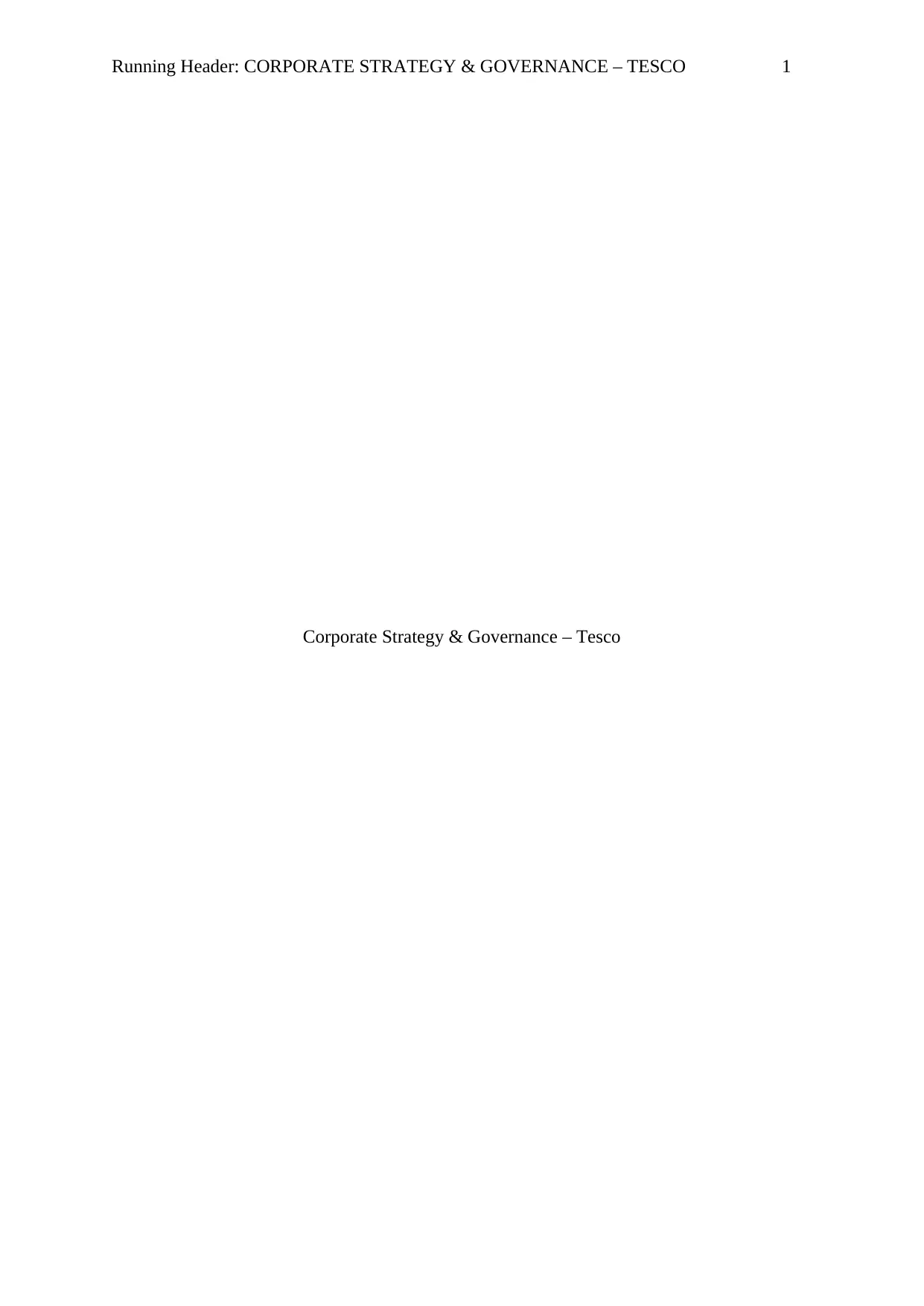
Running Header: CORPORATE STRATEGY & GOVERNANCE – TESCO 1
Corporate Strategy & Governance – Tesco
Corporate Strategy & Governance – Tesco
Secure Best Marks with AI Grader
Need help grading? Try our AI Grader for instant feedback on your assignments.
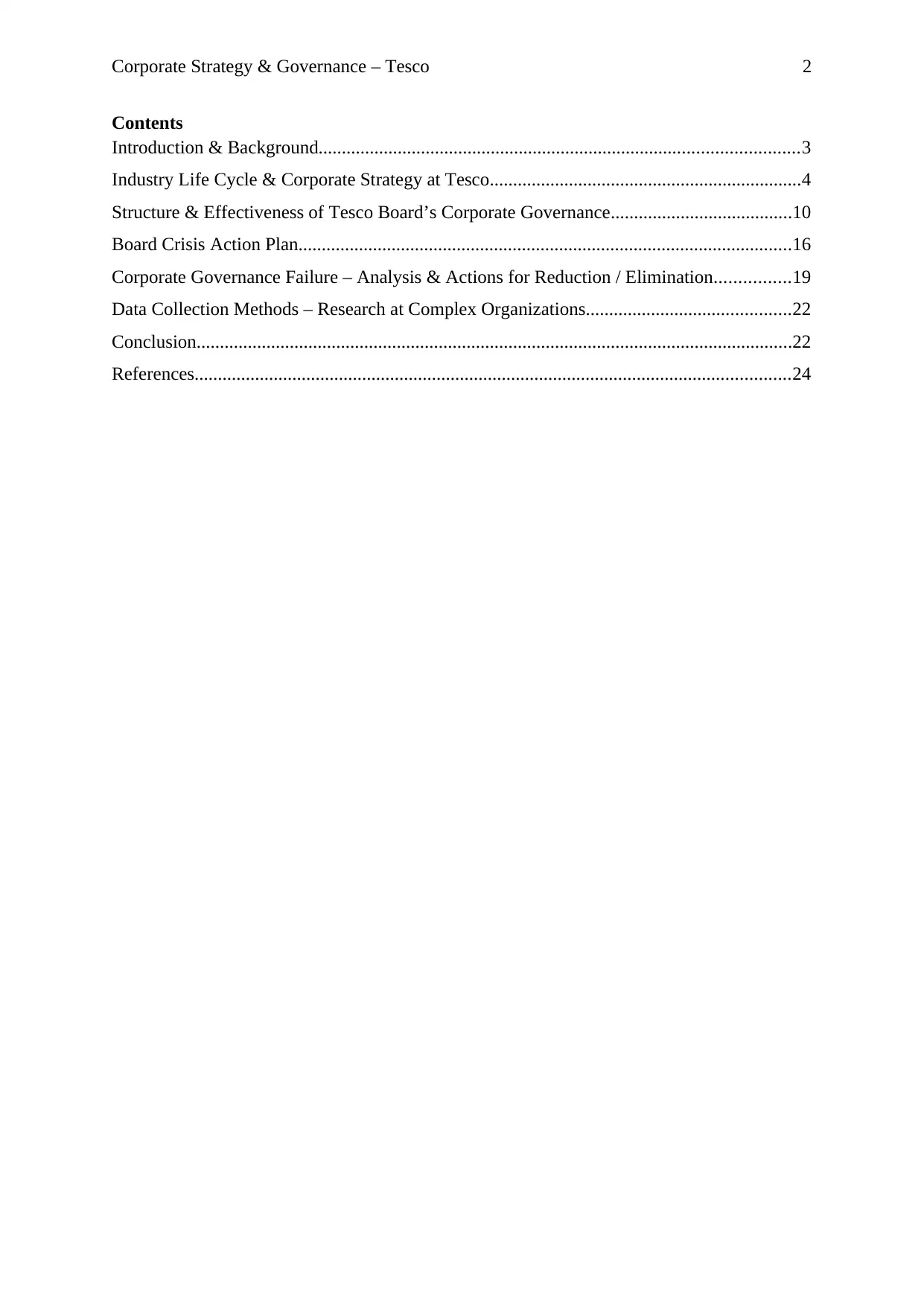
Corporate Strategy & Governance – Tesco 2
Contents
Introduction & Background.......................................................................................................3
Industry Life Cycle & Corporate Strategy at Tesco...................................................................4
Structure & Effectiveness of Tesco Board’s Corporate Governance.......................................10
Board Crisis Action Plan..........................................................................................................16
Corporate Governance Failure – Analysis & Actions for Reduction / Elimination................19
Data Collection Methods – Research at Complex Organizations............................................22
Conclusion................................................................................................................................22
References................................................................................................................................24
Contents
Introduction & Background.......................................................................................................3
Industry Life Cycle & Corporate Strategy at Tesco...................................................................4
Structure & Effectiveness of Tesco Board’s Corporate Governance.......................................10
Board Crisis Action Plan..........................................................................................................16
Corporate Governance Failure – Analysis & Actions for Reduction / Elimination................19
Data Collection Methods – Research at Complex Organizations............................................22
Conclusion................................................................................................................................22
References................................................................................................................................24

Corporate Strategy & Governance – Tesco 3
Introduction & Background
Strategic management represents a domain for the accountability management as well
as social responsibility in being an element of the vision / mission, as well as the interests of
shareholder are effectively highlighted which could interrupted by way of employee interests
or else environmental regulations / responsibilities leading to conflict in interest (Tricker and
Tricker 2015; Filatotchev and Nakajima 2014). The undertaking of business over longer term
forms the essential objective in the context of successfully and effectively managing
achievement which could take place by way of varied possibilities in attracting newer
investors. In this context, corporate governance helps in ensuring that the overall interest
amongst top tier managers are lined up / aligned towards the overall interests of the
shareholders, spanning across the various domains of interests amongst board of directors,
managers, and shareholders and these various domains comprise the electing of the board of
directors as well as chief executive manager, and also other set of stakeholders (Tricker and
Tricker 2015; Filatotchev and Nakajima 2014). At the outset corporate governance refers to
strategic direction and structure, which in turn illustrates corporate governance, possesses
managerial roles by way of varied tools which include legislations pertaining corporate
governance, ethics pertaining corporate governance, as well as responsibilities pertaining
corporate governance both in social and environmental contexts that could aid in achieving
the strategic objectives (Tricker and Tricker 2015; Filatotchev and Nakajima 2014).
Tesco PLC refers to United Kingdom based multinational grocery as well as general
merchandising retailer having its headquarters at Welwyn Garden City in Hertfordshire,
England. Tesco PLC represents third largest amongst the retailers across the globe measured
in terms of profits as well as represents ninth largest amongst the retailers across the globe
measured in terms of revenues (Tesco PLC 2017a). Tesco PLC owns stores across 12 nations
Introduction & Background
Strategic management represents a domain for the accountability management as well
as social responsibility in being an element of the vision / mission, as well as the interests of
shareholder are effectively highlighted which could interrupted by way of employee interests
or else environmental regulations / responsibilities leading to conflict in interest (Tricker and
Tricker 2015; Filatotchev and Nakajima 2014). The undertaking of business over longer term
forms the essential objective in the context of successfully and effectively managing
achievement which could take place by way of varied possibilities in attracting newer
investors. In this context, corporate governance helps in ensuring that the overall interest
amongst top tier managers are lined up / aligned towards the overall interests of the
shareholders, spanning across the various domains of interests amongst board of directors,
managers, and shareholders and these various domains comprise the electing of the board of
directors as well as chief executive manager, and also other set of stakeholders (Tricker and
Tricker 2015; Filatotchev and Nakajima 2014). At the outset corporate governance refers to
strategic direction and structure, which in turn illustrates corporate governance, possesses
managerial roles by way of varied tools which include legislations pertaining corporate
governance, ethics pertaining corporate governance, as well as responsibilities pertaining
corporate governance both in social and environmental contexts that could aid in achieving
the strategic objectives (Tricker and Tricker 2015; Filatotchev and Nakajima 2014).
Tesco PLC refers to United Kingdom based multinational grocery as well as general
merchandising retailer having its headquarters at Welwyn Garden City in Hertfordshire,
England. Tesco PLC represents third largest amongst the retailers across the globe measured
in terms of profits as well as represents ninth largest amongst the retailers across the globe
measured in terms of revenues (Tesco PLC 2017a). Tesco PLC owns stores across 12 nations
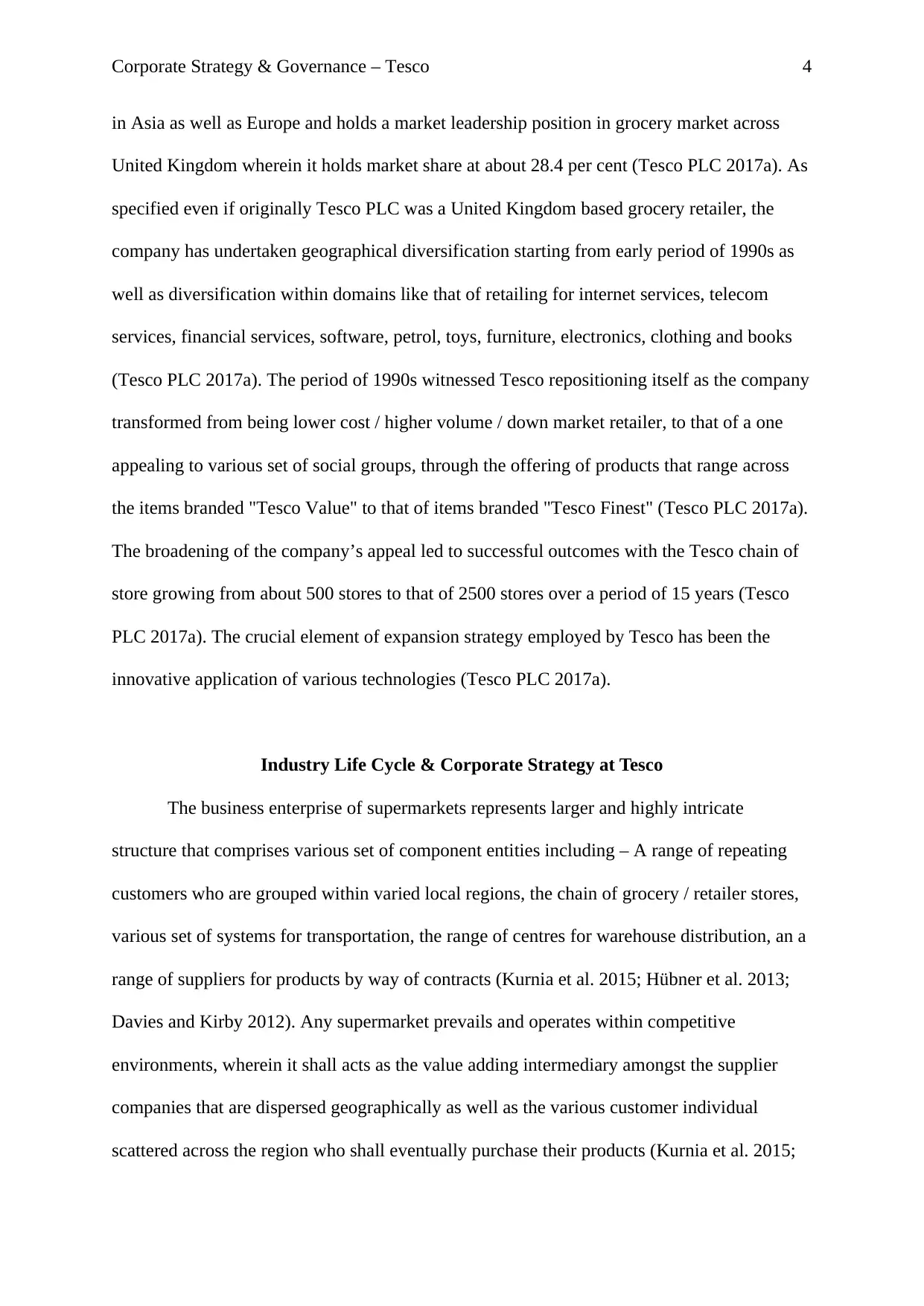
Corporate Strategy & Governance – Tesco 4
in Asia as well as Europe and holds a market leadership position in grocery market across
United Kingdom wherein it holds market share at about 28.4 per cent (Tesco PLC 2017a). As
specified even if originally Tesco PLC was a United Kingdom based grocery retailer, the
company has undertaken geographical diversification starting from early period of 1990s as
well as diversification within domains like that of retailing for internet services, telecom
services, financial services, software, petrol, toys, furniture, electronics, clothing and books
(Tesco PLC 2017a). The period of 1990s witnessed Tesco repositioning itself as the company
transformed from being lower cost / higher volume / down market retailer, to that of a one
appealing to various set of social groups, through the offering of products that range across
the items branded "Tesco Value" to that of items branded "Tesco Finest" (Tesco PLC 2017a).
The broadening of the company’s appeal led to successful outcomes with the Tesco chain of
store growing from about 500 stores to that of 2500 stores over a period of 15 years (Tesco
PLC 2017a). The crucial element of expansion strategy employed by Tesco has been the
innovative application of various technologies (Tesco PLC 2017a).
Industry Life Cycle & Corporate Strategy at Tesco
The business enterprise of supermarkets represents larger and highly intricate
structure that comprises various set of component entities including – A range of repeating
customers who are grouped within varied local regions, the chain of grocery / retailer stores,
various set of systems for transportation, the range of centres for warehouse distribution, an a
range of suppliers for products by way of contracts (Kurnia et al. 2015; Hübner et al. 2013;
Davies and Kirby 2012). Any supermarket prevails and operates within competitive
environments, wherein it shall acts as the value adding intermediary amongst the supplier
companies that are dispersed geographically as well as the various customer individual
scattered across the region who shall eventually purchase their products (Kurnia et al. 2015;
in Asia as well as Europe and holds a market leadership position in grocery market across
United Kingdom wherein it holds market share at about 28.4 per cent (Tesco PLC 2017a). As
specified even if originally Tesco PLC was a United Kingdom based grocery retailer, the
company has undertaken geographical diversification starting from early period of 1990s as
well as diversification within domains like that of retailing for internet services, telecom
services, financial services, software, petrol, toys, furniture, electronics, clothing and books
(Tesco PLC 2017a). The period of 1990s witnessed Tesco repositioning itself as the company
transformed from being lower cost / higher volume / down market retailer, to that of a one
appealing to various set of social groups, through the offering of products that range across
the items branded "Tesco Value" to that of items branded "Tesco Finest" (Tesco PLC 2017a).
The broadening of the company’s appeal led to successful outcomes with the Tesco chain of
store growing from about 500 stores to that of 2500 stores over a period of 15 years (Tesco
PLC 2017a). The crucial element of expansion strategy employed by Tesco has been the
innovative application of various technologies (Tesco PLC 2017a).
Industry Life Cycle & Corporate Strategy at Tesco
The business enterprise of supermarkets represents larger and highly intricate
structure that comprises various set of component entities including – A range of repeating
customers who are grouped within varied local regions, the chain of grocery / retailer stores,
various set of systems for transportation, the range of centres for warehouse distribution, an a
range of suppliers for products by way of contracts (Kurnia et al. 2015; Hübner et al. 2013;
Davies and Kirby 2012). Any supermarket prevails and operates within competitive
environments, wherein it shall acts as the value adding intermediary amongst the supplier
companies that are dispersed geographically as well as the various customer individual
scattered across the region who shall eventually purchase their products (Kurnia et al. 2015;
Secure Best Marks with AI Grader
Need help grading? Try our AI Grader for instant feedback on your assignments.
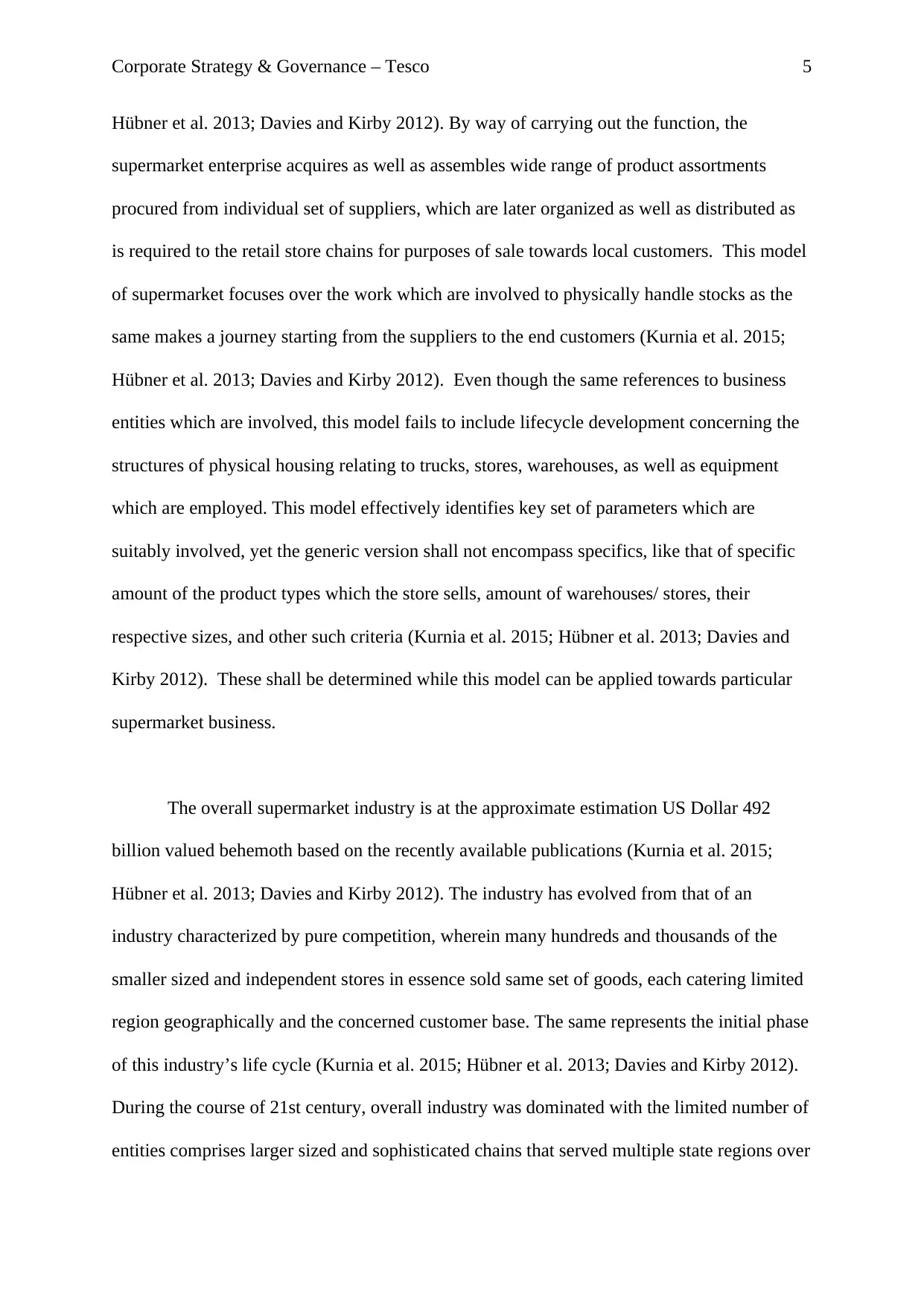
Corporate Strategy & Governance – Tesco 5
Hübner et al. 2013; Davies and Kirby 2012). By way of carrying out the function, the
supermarket enterprise acquires as well as assembles wide range of product assortments
procured from individual set of suppliers, which are later organized as well as distributed as
is required to the retail store chains for purposes of sale towards local customers. This model
of supermarket focuses over the work which are involved to physically handle stocks as the
same makes a journey starting from the suppliers to the end customers (Kurnia et al. 2015;
Hübner et al. 2013; Davies and Kirby 2012). Even though the same references to business
entities which are involved, this model fails to include lifecycle development concerning the
structures of physical housing relating to trucks, stores, warehouses, as well as equipment
which are employed. This model effectively identifies key set of parameters which are
suitably involved, yet the generic version shall not encompass specifics, like that of specific
amount of the product types which the store sells, amount of warehouses/ stores, their
respective sizes, and other such criteria (Kurnia et al. 2015; Hübner et al. 2013; Davies and
Kirby 2012). These shall be determined while this model can be applied towards particular
supermarket business.
The overall supermarket industry is at the approximate estimation US Dollar 492
billion valued behemoth based on the recently available publications (Kurnia et al. 2015;
Hübner et al. 2013; Davies and Kirby 2012). The industry has evolved from that of an
industry characterized by pure competition, wherein many hundreds and thousands of the
smaller sized and independent stores in essence sold same set of goods, each catering limited
region geographically and the concerned customer base. The same represents the initial phase
of this industry’s life cycle (Kurnia et al. 2015; Hübner et al. 2013; Davies and Kirby 2012).
During the course of 21st century, overall industry was dominated with the limited number of
entities comprises larger sized and sophisticated chains that served multiple state regions over
Hübner et al. 2013; Davies and Kirby 2012). By way of carrying out the function, the
supermarket enterprise acquires as well as assembles wide range of product assortments
procured from individual set of suppliers, which are later organized as well as distributed as
is required to the retail store chains for purposes of sale towards local customers. This model
of supermarket focuses over the work which are involved to physically handle stocks as the
same makes a journey starting from the suppliers to the end customers (Kurnia et al. 2015;
Hübner et al. 2013; Davies and Kirby 2012). Even though the same references to business
entities which are involved, this model fails to include lifecycle development concerning the
structures of physical housing relating to trucks, stores, warehouses, as well as equipment
which are employed. This model effectively identifies key set of parameters which are
suitably involved, yet the generic version shall not encompass specifics, like that of specific
amount of the product types which the store sells, amount of warehouses/ stores, their
respective sizes, and other such criteria (Kurnia et al. 2015; Hübner et al. 2013; Davies and
Kirby 2012). These shall be determined while this model can be applied towards particular
supermarket business.
The overall supermarket industry is at the approximate estimation US Dollar 492
billion valued behemoth based on the recently available publications (Kurnia et al. 2015;
Hübner et al. 2013; Davies and Kirby 2012). The industry has evolved from that of an
industry characterized by pure competition, wherein many hundreds and thousands of the
smaller sized and independent stores in essence sold same set of goods, each catering limited
region geographically and the concerned customer base. The same represents the initial phase
of this industry’s life cycle (Kurnia et al. 2015; Hübner et al. 2013; Davies and Kirby 2012).
During the course of 21st century, overall industry was dominated with the limited number of
entities comprises larger sized and sophisticated chains that served multiple state regions over

Corporate Strategy & Governance – Tesco 6
more of oligarchy based structure with mature phase of this industry’s life cycle. The
evolution of life cycle from various smaller and independent retailers to that of fewer larger
sized chains could be explained in the best manner by way of the theory termed as Wheel of
Retailing (Kurnia et al. 2015; Hübner et al. 2013; Davies and Kirby 2012). This theory
essentially postulates that any store shall start out by serving limited market by using smaller
product mix, lower prices levels as well as lower margins (Kurnia et al. 2015; Hübner et al.
2013; Davies and Kirby 2012).
With the growth in the store, the same shall expand the relevant product mix,
enhancement to the facilities, as well as increase in services. The same shall eventually add to
overall costs of the operations, with consequent increases in the price margins (Kurnia et al.
2015; Hübner et al. 2013; Davies and Kirby 2012). With the continual growth in the store, the
business shall follow the similar approach concerning increases in product mix, enhancement
to the facilities, as well as increase in services. It shall expand by way of opening additional
set of stores as well as expansion of the marketing areas and all of these shall continue the
overall need for increasing prices as well as margins (Kurnia et al. 2015; Hübner et al. 2013;
Davies and Kirby 2012). If the same could be successfully managed, at an eventual time the
relevant operation could become increasingly sophisticated form of chain serving to the
multi-state regions. Naturally various other entrepreneurs shall endeavour in taking the
market share through opening of stores serving to limited market armed by smaller product
mix, lower prices, lower margins as well as limited set of services within facilities that are
bare-bones (Kurnia et al. 2015; Hübner et al. 2013; Davies and Kirby 2012). As these entities
grow, they shall follow same set of format as compared to their respective predecessors, as
well as at an eventual time become much more effective through learning derived from
experience as well as delivering an effective job, forcing them towards the phase of decline in
more of oligarchy based structure with mature phase of this industry’s life cycle. The
evolution of life cycle from various smaller and independent retailers to that of fewer larger
sized chains could be explained in the best manner by way of the theory termed as Wheel of
Retailing (Kurnia et al. 2015; Hübner et al. 2013; Davies and Kirby 2012). This theory
essentially postulates that any store shall start out by serving limited market by using smaller
product mix, lower prices levels as well as lower margins (Kurnia et al. 2015; Hübner et al.
2013; Davies and Kirby 2012).
With the growth in the store, the same shall expand the relevant product mix,
enhancement to the facilities, as well as increase in services. The same shall eventually add to
overall costs of the operations, with consequent increases in the price margins (Kurnia et al.
2015; Hübner et al. 2013; Davies and Kirby 2012). With the continual growth in the store, the
business shall follow the similar approach concerning increases in product mix, enhancement
to the facilities, as well as increase in services. It shall expand by way of opening additional
set of stores as well as expansion of the marketing areas and all of these shall continue the
overall need for increasing prices as well as margins (Kurnia et al. 2015; Hübner et al. 2013;
Davies and Kirby 2012). If the same could be successfully managed, at an eventual time the
relevant operation could become increasingly sophisticated form of chain serving to the
multi-state regions. Naturally various other entrepreneurs shall endeavour in taking the
market share through opening of stores serving to limited market armed by smaller product
mix, lower prices, lower margins as well as limited set of services within facilities that are
bare-bones (Kurnia et al. 2015; Hübner et al. 2013; Davies and Kirby 2012). As these entities
grow, they shall follow same set of format as compared to their respective predecessors, as
well as at an eventual time become much more effective through learning derived from
experience as well as delivering an effective job, forcing them towards the phase of decline in
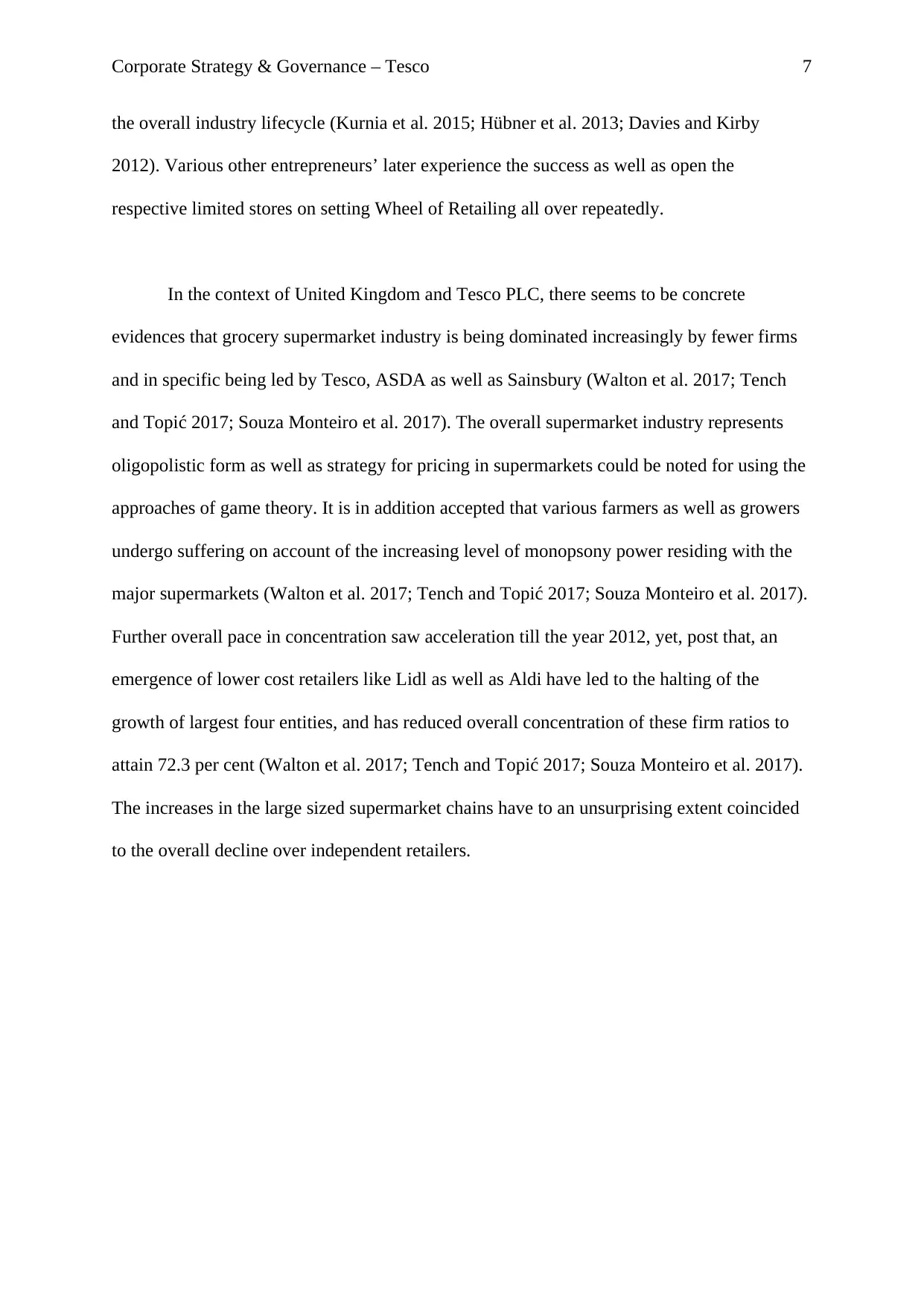
Corporate Strategy & Governance – Tesco 7
the overall industry lifecycle (Kurnia et al. 2015; Hübner et al. 2013; Davies and Kirby
2012). Various other entrepreneurs’ later experience the success as well as open the
respective limited stores on setting Wheel of Retailing all over repeatedly.
In the context of United Kingdom and Tesco PLC, there seems to be concrete
evidences that grocery supermarket industry is being dominated increasingly by fewer firms
and in specific being led by Tesco, ASDA as well as Sainsbury (Walton et al. 2017; Tench
and Topić 2017; Souza Monteiro et al. 2017). The overall supermarket industry represents
oligopolistic form as well as strategy for pricing in supermarkets could be noted for using the
approaches of game theory. It is in addition accepted that various farmers as well as growers
undergo suffering on account of the increasing level of monopsony power residing with the
major supermarkets (Walton et al. 2017; Tench and Topić 2017; Souza Monteiro et al. 2017).
Further overall pace in concentration saw acceleration till the year 2012, yet, post that, an
emergence of lower cost retailers like Lidl as well as Aldi have led to the halting of the
growth of largest four entities, and has reduced overall concentration of these firm ratios to
attain 72.3 per cent (Walton et al. 2017; Tench and Topić 2017; Souza Monteiro et al. 2017).
The increases in the large sized supermarket chains have to an unsurprising extent coincided
to the overall decline over independent retailers.
the overall industry lifecycle (Kurnia et al. 2015; Hübner et al. 2013; Davies and Kirby
2012). Various other entrepreneurs’ later experience the success as well as open the
respective limited stores on setting Wheel of Retailing all over repeatedly.
In the context of United Kingdom and Tesco PLC, there seems to be concrete
evidences that grocery supermarket industry is being dominated increasingly by fewer firms
and in specific being led by Tesco, ASDA as well as Sainsbury (Walton et al. 2017; Tench
and Topić 2017; Souza Monteiro et al. 2017). The overall supermarket industry represents
oligopolistic form as well as strategy for pricing in supermarkets could be noted for using the
approaches of game theory. It is in addition accepted that various farmers as well as growers
undergo suffering on account of the increasing level of monopsony power residing with the
major supermarkets (Walton et al. 2017; Tench and Topić 2017; Souza Monteiro et al. 2017).
Further overall pace in concentration saw acceleration till the year 2012, yet, post that, an
emergence of lower cost retailers like Lidl as well as Aldi have led to the halting of the
growth of largest four entities, and has reduced overall concentration of these firm ratios to
attain 72.3 per cent (Walton et al. 2017; Tench and Topić 2017; Souza Monteiro et al. 2017).
The increases in the large sized supermarket chains have to an unsurprising extent coincided
to the overall decline over independent retailers.
Paraphrase This Document
Need a fresh take? Get an instant paraphrase of this document with our AI Paraphraser
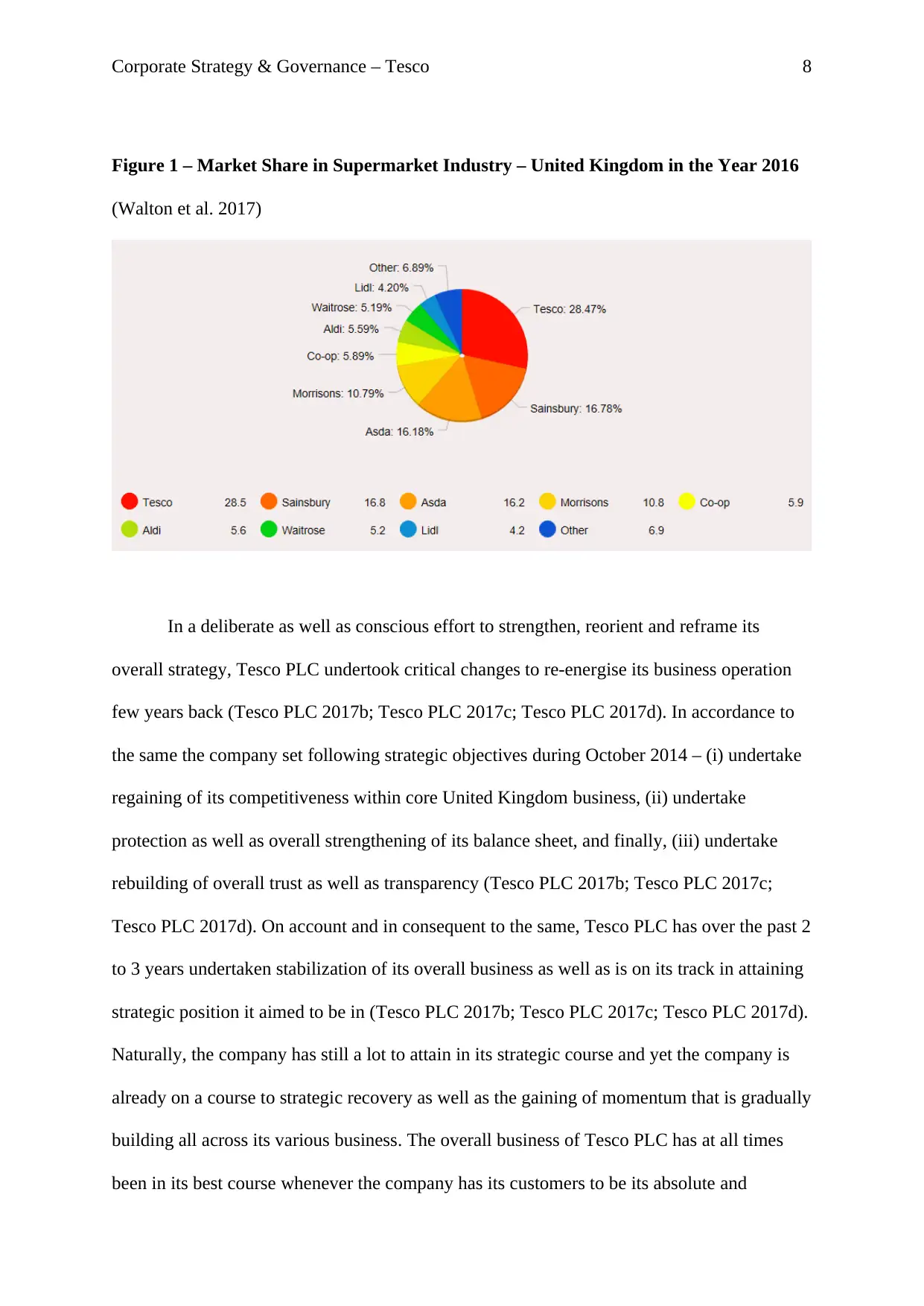
Corporate Strategy & Governance – Tesco 8
Figure 1 – Market Share in Supermarket Industry – United Kingdom in the Year 2016
(Walton et al. 2017)
In a deliberate as well as conscious effort to strengthen, reorient and reframe its
overall strategy, Tesco PLC undertook critical changes to re-energise its business operation
few years back (Tesco PLC 2017b; Tesco PLC 2017c; Tesco PLC 2017d). In accordance to
the same the company set following strategic objectives during October 2014 – (i) undertake
regaining of its competitiveness within core United Kingdom business, (ii) undertake
protection as well as overall strengthening of its balance sheet, and finally, (iii) undertake
rebuilding of overall trust as well as transparency (Tesco PLC 2017b; Tesco PLC 2017c;
Tesco PLC 2017d). On account and in consequent to the same, Tesco PLC has over the past 2
to 3 years undertaken stabilization of its overall business as well as is on its track in attaining
strategic position it aimed to be in (Tesco PLC 2017b; Tesco PLC 2017c; Tesco PLC 2017d).
Naturally, the company has still a lot to attain in its strategic course and yet the company is
already on a course to strategic recovery as well as the gaining of momentum that is gradually
building all across its various business. The overall business of Tesco PLC has at all times
been in its best course whenever the company has its customers to be its absolute and
Figure 1 – Market Share in Supermarket Industry – United Kingdom in the Year 2016
(Walton et al. 2017)
In a deliberate as well as conscious effort to strengthen, reorient and reframe its
overall strategy, Tesco PLC undertook critical changes to re-energise its business operation
few years back (Tesco PLC 2017b; Tesco PLC 2017c; Tesco PLC 2017d). In accordance to
the same the company set following strategic objectives during October 2014 – (i) undertake
regaining of its competitiveness within core United Kingdom business, (ii) undertake
protection as well as overall strengthening of its balance sheet, and finally, (iii) undertake
rebuilding of overall trust as well as transparency (Tesco PLC 2017b; Tesco PLC 2017c;
Tesco PLC 2017d). On account and in consequent to the same, Tesco PLC has over the past 2
to 3 years undertaken stabilization of its overall business as well as is on its track in attaining
strategic position it aimed to be in (Tesco PLC 2017b; Tesco PLC 2017c; Tesco PLC 2017d).
Naturally, the company has still a lot to attain in its strategic course and yet the company is
already on a course to strategic recovery as well as the gaining of momentum that is gradually
building all across its various business. The overall business of Tesco PLC has at all times
been in its best course whenever the company has its customers to be its absolute and

Corporate Strategy & Governance – Tesco 9
ultimate priority. Over past year or so, the company has restored its overall commitment
for delivering best possible services to its end customers (Tesco PLC 2017b; Tesco PLC
2017c; Tesco PLC 2017d). The same has been reflected within its newer purpose that has
been established for its businesses – serving the shoppers little better on a day to day basis.
The same has been guiding force for each of its action the company has since been taking as
well as has been effectively instrumental to make the overall United Kingdom operations to
be competitive again (Tesco PLC 2017b; Tesco PLC 2017c; Tesco PLC 2017d).
In addition, over the contexts of investments for lower, highly stable form of pricing
as well as enhanced servicing / availability, the company has undertaken review and suitably
simplified each one of its food product ranges as well as undertaken increases in the
additional man hours across the company’s shop floor for enhancing the customer service
(Tesco PLC 2017b; Tesco PLC 2017c; Tesco PLC 2017d). The availability on-shelf has
attained levels never before levels, make sure that its customers could avail what they desire
and at all times they want the same. In a remarkable milestone, the company became first and
till date sole retailer within United Kingdom during October 2015 for offering customers with
immediate price matches in addition to Brand Guarantee, such they never have to pay higher
at the branded shops in case they are cheaper across Sainsbury’s, Morrisons or Asda while
they could purchase 5 or else more different set of products (Tesco PLC 2017b; Tesco PLC
2017c; Tesco PLC 2017d). In terms of recent strategic changes, the company came out with
suite of new and exclusive set of brands for fresh food that are available solely at the Tesco
outlets and offered at attractive prices. The same shall enable the company in giving its
customers much more enhanced choice with greater value and fresher food at one single
outlet (Tesco PLC 2017b; Tesco PLC 2017c; Tesco PLC 2017d).
ultimate priority. Over past year or so, the company has restored its overall commitment
for delivering best possible services to its end customers (Tesco PLC 2017b; Tesco PLC
2017c; Tesco PLC 2017d). The same has been reflected within its newer purpose that has
been established for its businesses – serving the shoppers little better on a day to day basis.
The same has been guiding force for each of its action the company has since been taking as
well as has been effectively instrumental to make the overall United Kingdom operations to
be competitive again (Tesco PLC 2017b; Tesco PLC 2017c; Tesco PLC 2017d).
In addition, over the contexts of investments for lower, highly stable form of pricing
as well as enhanced servicing / availability, the company has undertaken review and suitably
simplified each one of its food product ranges as well as undertaken increases in the
additional man hours across the company’s shop floor for enhancing the customer service
(Tesco PLC 2017b; Tesco PLC 2017c; Tesco PLC 2017d). The availability on-shelf has
attained levels never before levels, make sure that its customers could avail what they desire
and at all times they want the same. In a remarkable milestone, the company became first and
till date sole retailer within United Kingdom during October 2015 for offering customers with
immediate price matches in addition to Brand Guarantee, such they never have to pay higher
at the branded shops in case they are cheaper across Sainsbury’s, Morrisons or Asda while
they could purchase 5 or else more different set of products (Tesco PLC 2017b; Tesco PLC
2017c; Tesco PLC 2017d). In terms of recent strategic changes, the company came out with
suite of new and exclusive set of brands for fresh food that are available solely at the Tesco
outlets and offered at attractive prices. The same shall enable the company in giving its
customers much more enhanced choice with greater value and fresher food at one single
outlet (Tesco PLC 2017b; Tesco PLC 2017c; Tesco PLC 2017d).
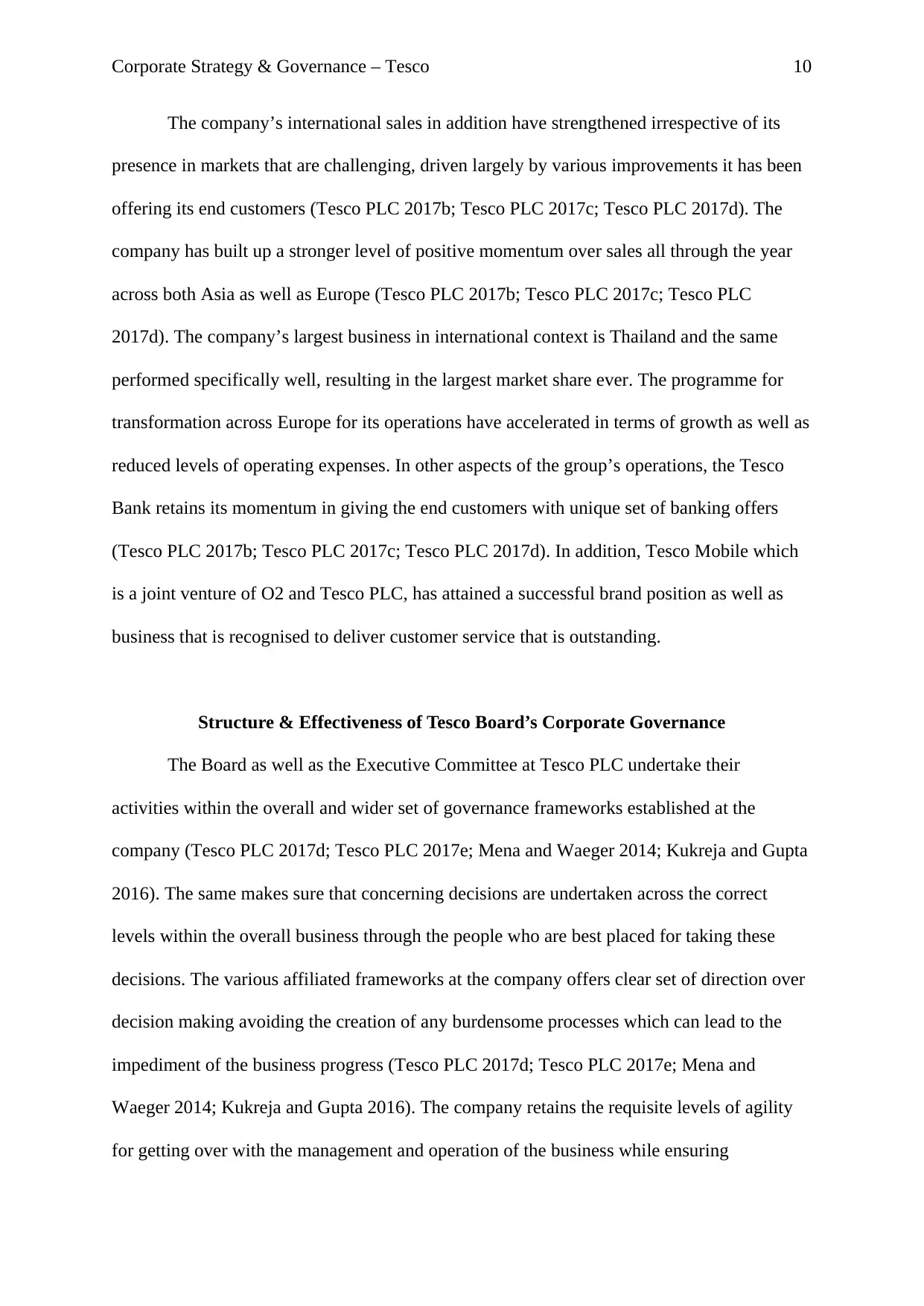
Corporate Strategy & Governance – Tesco 10
The company’s international sales in addition have strengthened irrespective of its
presence in markets that are challenging, driven largely by various improvements it has been
offering its end customers (Tesco PLC 2017b; Tesco PLC 2017c; Tesco PLC 2017d). The
company has built up a stronger level of positive momentum over sales all through the year
across both Asia as well as Europe (Tesco PLC 2017b; Tesco PLC 2017c; Tesco PLC
2017d). The company’s largest business in international context is Thailand and the same
performed specifically well, resulting in the largest market share ever. The programme for
transformation across Europe for its operations have accelerated in terms of growth as well as
reduced levels of operating expenses. In other aspects of the group’s operations, the Tesco
Bank retains its momentum in giving the end customers with unique set of banking offers
(Tesco PLC 2017b; Tesco PLC 2017c; Tesco PLC 2017d). In addition, Tesco Mobile which
is a joint venture of O2 and Tesco PLC, has attained a successful brand position as well as
business that is recognised to deliver customer service that is outstanding.
Structure & Effectiveness of Tesco Board’s Corporate Governance
The Board as well as the Executive Committee at Tesco PLC undertake their
activities within the overall and wider set of governance frameworks established at the
company (Tesco PLC 2017d; Tesco PLC 2017e; Mena and Waeger 2014; Kukreja and Gupta
2016). The same makes sure that concerning decisions are undertaken across the correct
levels within the overall business through the people who are best placed for taking these
decisions. The various affiliated frameworks at the company offers clear set of direction over
decision making avoiding the creation of any burdensome processes which can lead to the
impediment of the business progress (Tesco PLC 2017d; Tesco PLC 2017e; Mena and
Waeger 2014; Kukreja and Gupta 2016). The company retains the requisite levels of agility
for getting over with the management and operation of the business while ensuring
The company’s international sales in addition have strengthened irrespective of its
presence in markets that are challenging, driven largely by various improvements it has been
offering its end customers (Tesco PLC 2017b; Tesco PLC 2017c; Tesco PLC 2017d). The
company has built up a stronger level of positive momentum over sales all through the year
across both Asia as well as Europe (Tesco PLC 2017b; Tesco PLC 2017c; Tesco PLC
2017d). The company’s largest business in international context is Thailand and the same
performed specifically well, resulting in the largest market share ever. The programme for
transformation across Europe for its operations have accelerated in terms of growth as well as
reduced levels of operating expenses. In other aspects of the group’s operations, the Tesco
Bank retains its momentum in giving the end customers with unique set of banking offers
(Tesco PLC 2017b; Tesco PLC 2017c; Tesco PLC 2017d). In addition, Tesco Mobile which
is a joint venture of O2 and Tesco PLC, has attained a successful brand position as well as
business that is recognised to deliver customer service that is outstanding.
Structure & Effectiveness of Tesco Board’s Corporate Governance
The Board as well as the Executive Committee at Tesco PLC undertake their
activities within the overall and wider set of governance frameworks established at the
company (Tesco PLC 2017d; Tesco PLC 2017e; Mena and Waeger 2014; Kukreja and Gupta
2016). The same makes sure that concerning decisions are undertaken across the correct
levels within the overall business through the people who are best placed for taking these
decisions. The various affiliated frameworks at the company offers clear set of direction over
decision making avoiding the creation of any burdensome processes which can lead to the
impediment of the business progress (Tesco PLC 2017d; Tesco PLC 2017e; Mena and
Waeger 2014; Kukreja and Gupta 2016). The company retains the requisite levels of agility
for getting over with the management and operation of the business while ensuring
Secure Best Marks with AI Grader
Need help grading? Try our AI Grader for instant feedback on your assignments.
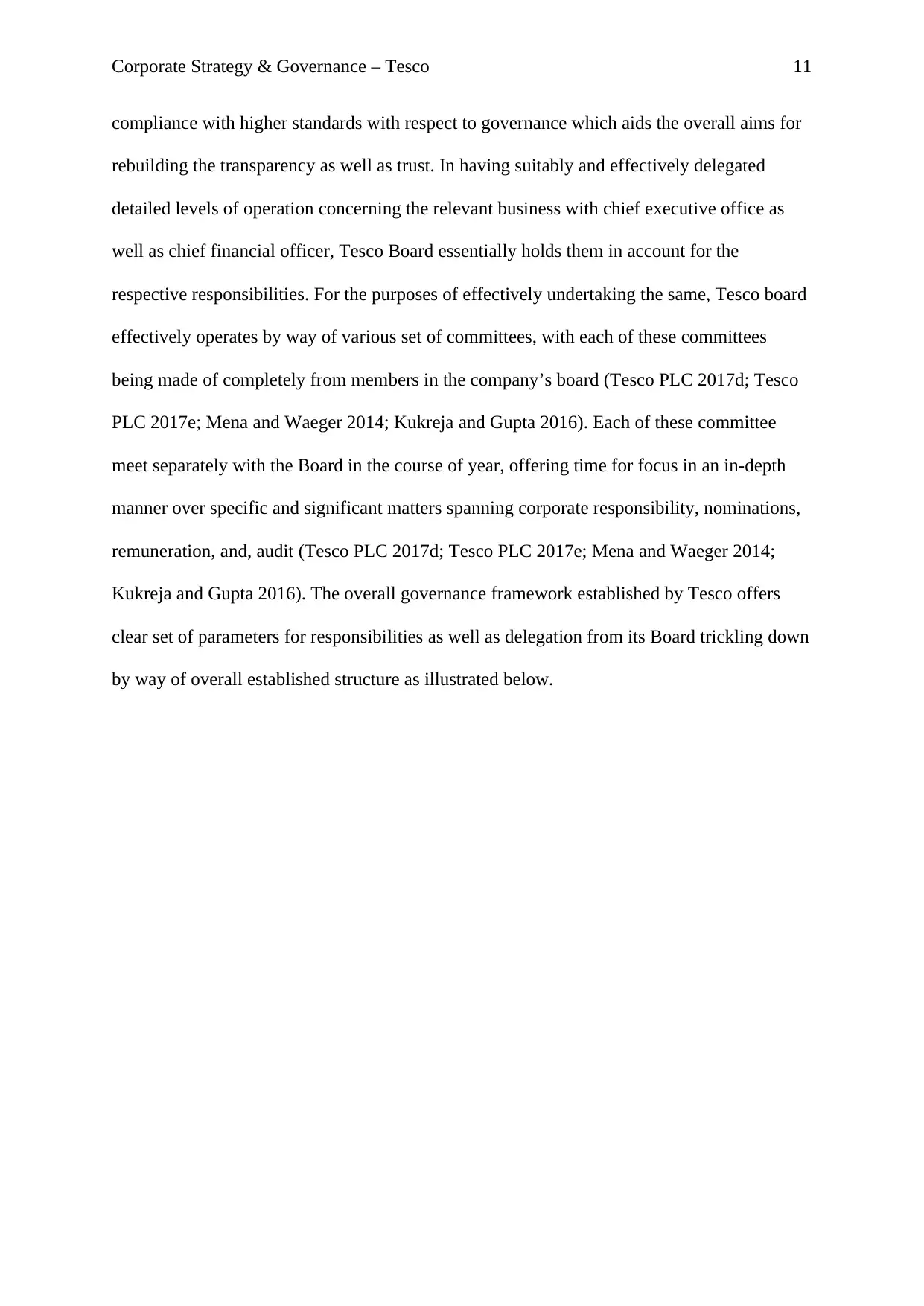
Corporate Strategy & Governance – Tesco 11
compliance with higher standards with respect to governance which aids the overall aims for
rebuilding the transparency as well as trust. In having suitably and effectively delegated
detailed levels of operation concerning the relevant business with chief executive office as
well as chief financial officer, Tesco Board essentially holds them in account for the
respective responsibilities. For the purposes of effectively undertaking the same, Tesco board
effectively operates by way of various set of committees, with each of these committees
being made of completely from members in the company’s board (Tesco PLC 2017d; Tesco
PLC 2017e; Mena and Waeger 2014; Kukreja and Gupta 2016). Each of these committee
meet separately with the Board in the course of year, offering time for focus in an in-depth
manner over specific and significant matters spanning corporate responsibility, nominations,
remuneration, and, audit (Tesco PLC 2017d; Tesco PLC 2017e; Mena and Waeger 2014;
Kukreja and Gupta 2016). The overall governance framework established by Tesco offers
clear set of parameters for responsibilities as well as delegation from its Board trickling down
by way of overall established structure as illustrated below.
compliance with higher standards with respect to governance which aids the overall aims for
rebuilding the transparency as well as trust. In having suitably and effectively delegated
detailed levels of operation concerning the relevant business with chief executive office as
well as chief financial officer, Tesco Board essentially holds them in account for the
respective responsibilities. For the purposes of effectively undertaking the same, Tesco board
effectively operates by way of various set of committees, with each of these committees
being made of completely from members in the company’s board (Tesco PLC 2017d; Tesco
PLC 2017e; Mena and Waeger 2014; Kukreja and Gupta 2016). Each of these committee
meet separately with the Board in the course of year, offering time for focus in an in-depth
manner over specific and significant matters spanning corporate responsibility, nominations,
remuneration, and, audit (Tesco PLC 2017d; Tesco PLC 2017e; Mena and Waeger 2014;
Kukreja and Gupta 2016). The overall governance framework established by Tesco offers
clear set of parameters for responsibilities as well as delegation from its Board trickling down
by way of overall established structure as illustrated below.
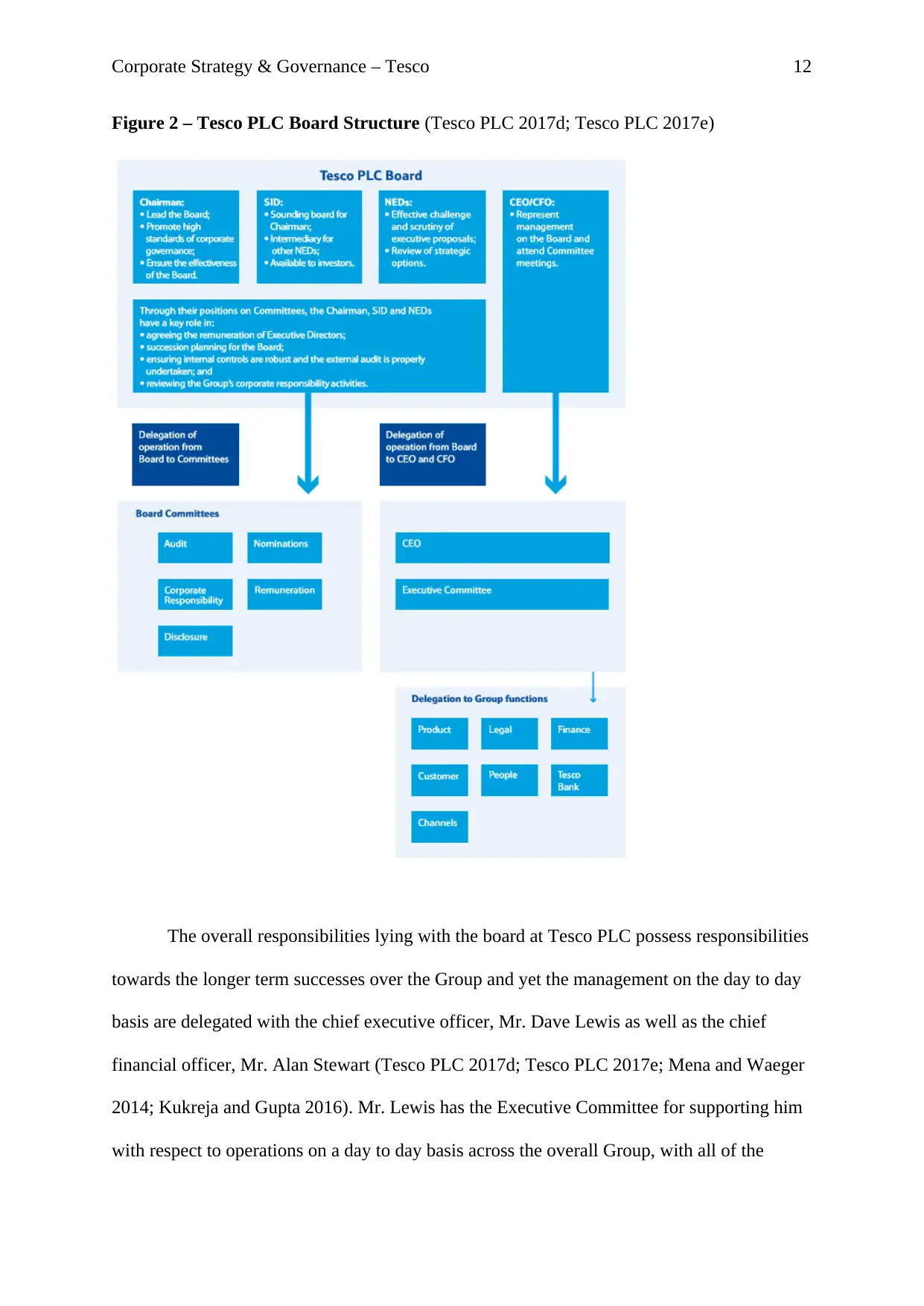
Corporate Strategy & Governance – Tesco 12
Figure 2 – Tesco PLC Board Structure (Tesco PLC 2017d; Tesco PLC 2017e)
The overall responsibilities lying with the board at Tesco PLC possess responsibilities
towards the longer term successes over the Group and yet the management on the day to day
basis are delegated with the chief executive officer, Mr. Dave Lewis as well as the chief
financial officer, Mr. Alan Stewart (Tesco PLC 2017d; Tesco PLC 2017e; Mena and Waeger
2014; Kukreja and Gupta 2016). Mr. Lewis has the Executive Committee for supporting him
with respect to operations on a day to day basis across the overall Group, with all of the
Figure 2 – Tesco PLC Board Structure (Tesco PLC 2017d; Tesco PLC 2017e)
The overall responsibilities lying with the board at Tesco PLC possess responsibilities
towards the longer term successes over the Group and yet the management on the day to day
basis are delegated with the chief executive officer, Mr. Dave Lewis as well as the chief
financial officer, Mr. Alan Stewart (Tesco PLC 2017d; Tesco PLC 2017e; Mena and Waeger
2014; Kukreja and Gupta 2016). Mr. Lewis has the Executive Committee for supporting him
with respect to operations on a day to day basis across the overall Group, with all of the
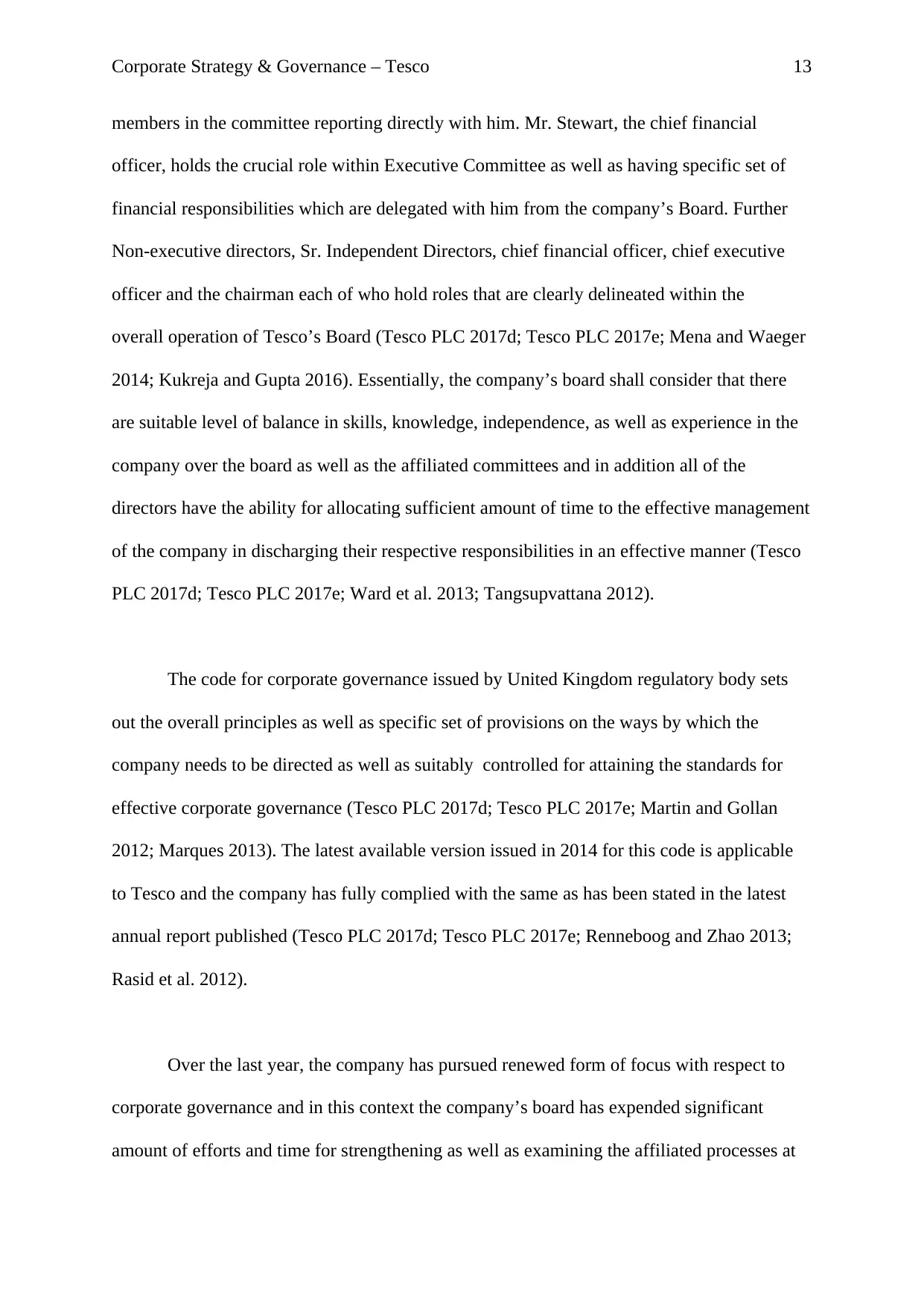
Corporate Strategy & Governance – Tesco 13
members in the committee reporting directly with him. Mr. Stewart, the chief financial
officer, holds the crucial role within Executive Committee as well as having specific set of
financial responsibilities which are delegated with him from the company’s Board. Further
Non-executive directors, Sr. Independent Directors, chief financial officer, chief executive
officer and the chairman each of who hold roles that are clearly delineated within the
overall operation of Tesco’s Board (Tesco PLC 2017d; Tesco PLC 2017e; Mena and Waeger
2014; Kukreja and Gupta 2016). Essentially, the company’s board shall consider that there
are suitable level of balance in skills, knowledge, independence, as well as experience in the
company over the board as well as the affiliated committees and in addition all of the
directors have the ability for allocating sufficient amount of time to the effective management
of the company in discharging their respective responsibilities in an effective manner (Tesco
PLC 2017d; Tesco PLC 2017e; Ward et al. 2013; Tangsupvattana 2012).
The code for corporate governance issued by United Kingdom regulatory body sets
out the overall principles as well as specific set of provisions on the ways by which the
company needs to be directed as well as suitably controlled for attaining the standards for
effective corporate governance (Tesco PLC 2017d; Tesco PLC 2017e; Martin and Gollan
2012; Marques 2013). The latest available version issued in 2014 for this code is applicable
to Tesco and the company has fully complied with the same as has been stated in the latest
annual report published (Tesco PLC 2017d; Tesco PLC 2017e; Renneboog and Zhao 2013;
Rasid et al. 2012).
Over the last year, the company has pursued renewed form of focus with respect to
corporate governance and in this context the company’s board has expended significant
amount of efforts and time for strengthening as well as examining the affiliated processes at
members in the committee reporting directly with him. Mr. Stewart, the chief financial
officer, holds the crucial role within Executive Committee as well as having specific set of
financial responsibilities which are delegated with him from the company’s Board. Further
Non-executive directors, Sr. Independent Directors, chief financial officer, chief executive
officer and the chairman each of who hold roles that are clearly delineated within the
overall operation of Tesco’s Board (Tesco PLC 2017d; Tesco PLC 2017e; Mena and Waeger
2014; Kukreja and Gupta 2016). Essentially, the company’s board shall consider that there
are suitable level of balance in skills, knowledge, independence, as well as experience in the
company over the board as well as the affiliated committees and in addition all of the
directors have the ability for allocating sufficient amount of time to the effective management
of the company in discharging their respective responsibilities in an effective manner (Tesco
PLC 2017d; Tesco PLC 2017e; Ward et al. 2013; Tangsupvattana 2012).
The code for corporate governance issued by United Kingdom regulatory body sets
out the overall principles as well as specific set of provisions on the ways by which the
company needs to be directed as well as suitably controlled for attaining the standards for
effective corporate governance (Tesco PLC 2017d; Tesco PLC 2017e; Martin and Gollan
2012; Marques 2013). The latest available version issued in 2014 for this code is applicable
to Tesco and the company has fully complied with the same as has been stated in the latest
annual report published (Tesco PLC 2017d; Tesco PLC 2017e; Renneboog and Zhao 2013;
Rasid et al. 2012).
Over the last year, the company has pursued renewed form of focus with respect to
corporate governance and in this context the company’s board has expended significant
amount of efforts and time for strengthening as well as examining the affiliated processes at
Paraphrase This Document
Need a fresh take? Get an instant paraphrase of this document with our AI Paraphraser
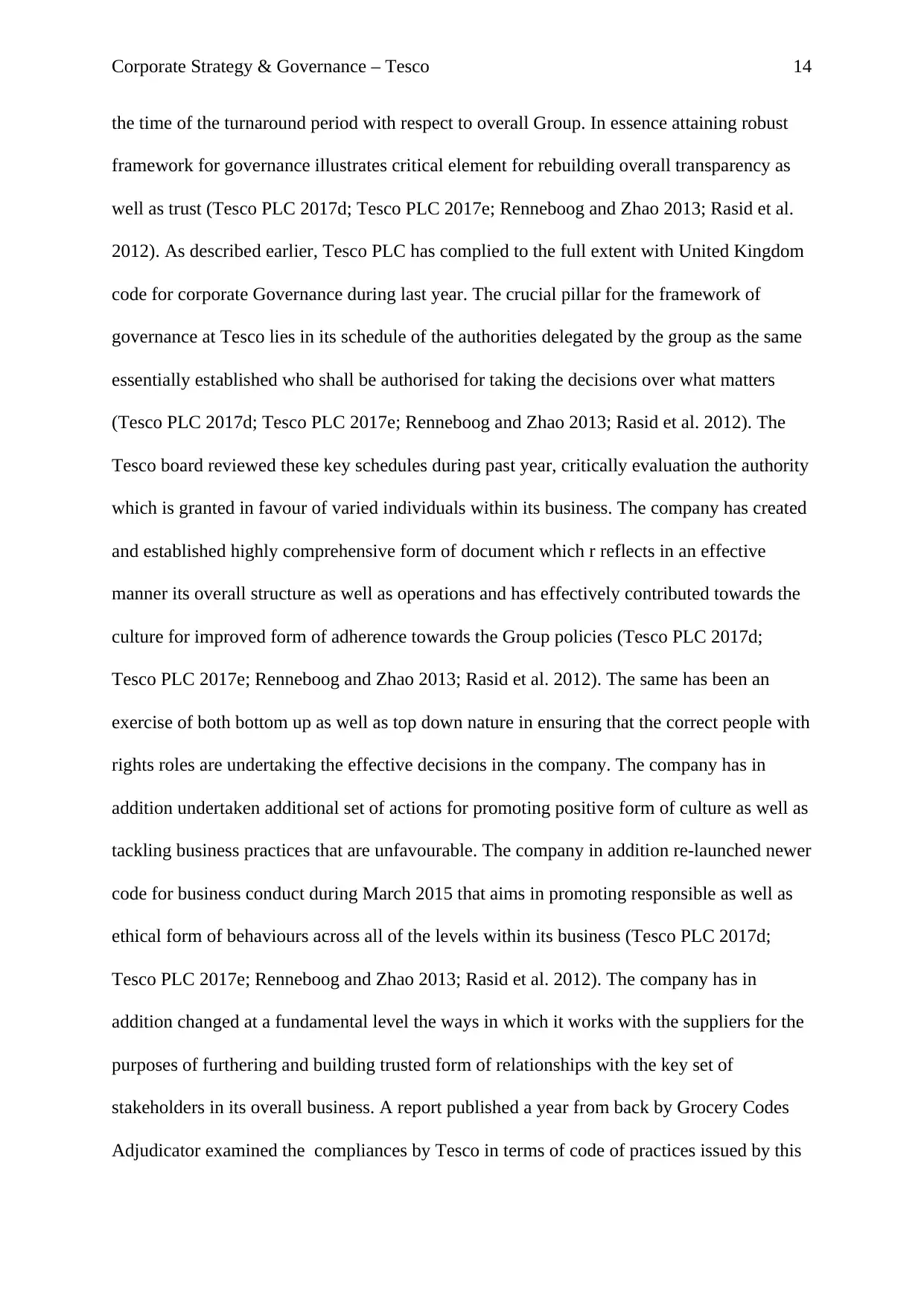
Corporate Strategy & Governance – Tesco 14
the time of the turnaround period with respect to overall Group. In essence attaining robust
framework for governance illustrates critical element for rebuilding overall transparency as
well as trust (Tesco PLC 2017d; Tesco PLC 2017e; Renneboog and Zhao 2013; Rasid et al.
2012). As described earlier, Tesco PLC has complied to the full extent with United Kingdom
code for corporate Governance during last year. The crucial pillar for the framework of
governance at Tesco lies in its schedule of the authorities delegated by the group as the same
essentially established who shall be authorised for taking the decisions over what matters
(Tesco PLC 2017d; Tesco PLC 2017e; Renneboog and Zhao 2013; Rasid et al. 2012). The
Tesco board reviewed these key schedules during past year, critically evaluation the authority
which is granted in favour of varied individuals within its business. The company has created
and established highly comprehensive form of document which r reflects in an effective
manner its overall structure as well as operations and has effectively contributed towards the
culture for improved form of adherence towards the Group policies (Tesco PLC 2017d;
Tesco PLC 2017e; Renneboog and Zhao 2013; Rasid et al. 2012). The same has been an
exercise of both bottom up as well as top down nature in ensuring that the correct people with
rights roles are undertaking the effective decisions in the company. The company has in
addition undertaken additional set of actions for promoting positive form of culture as well as
tackling business practices that are unfavourable. The company in addition re-launched newer
code for business conduct during March 2015 that aims in promoting responsible as well as
ethical form of behaviours across all of the levels within its business (Tesco PLC 2017d;
Tesco PLC 2017e; Renneboog and Zhao 2013; Rasid et al. 2012). The company has in
addition changed at a fundamental level the ways in which it works with the suppliers for the
purposes of furthering and building trusted form of relationships with the key set of
stakeholders in its overall business. A report published a year from back by Grocery Codes
Adjudicator examined the compliances by Tesco in terms of code of practices issued by this
the time of the turnaround period with respect to overall Group. In essence attaining robust
framework for governance illustrates critical element for rebuilding overall transparency as
well as trust (Tesco PLC 2017d; Tesco PLC 2017e; Renneboog and Zhao 2013; Rasid et al.
2012). As described earlier, Tesco PLC has complied to the full extent with United Kingdom
code for corporate Governance during last year. The crucial pillar for the framework of
governance at Tesco lies in its schedule of the authorities delegated by the group as the same
essentially established who shall be authorised for taking the decisions over what matters
(Tesco PLC 2017d; Tesco PLC 2017e; Renneboog and Zhao 2013; Rasid et al. 2012). The
Tesco board reviewed these key schedules during past year, critically evaluation the authority
which is granted in favour of varied individuals within its business. The company has created
and established highly comprehensive form of document which r reflects in an effective
manner its overall structure as well as operations and has effectively contributed towards the
culture for improved form of adherence towards the Group policies (Tesco PLC 2017d;
Tesco PLC 2017e; Renneboog and Zhao 2013; Rasid et al. 2012). The same has been an
exercise of both bottom up as well as top down nature in ensuring that the correct people with
rights roles are undertaking the effective decisions in the company. The company has in
addition undertaken additional set of actions for promoting positive form of culture as well as
tackling business practices that are unfavourable. The company in addition re-launched newer
code for business conduct during March 2015 that aims in promoting responsible as well as
ethical form of behaviours across all of the levels within its business (Tesco PLC 2017d;
Tesco PLC 2017e; Renneboog and Zhao 2013; Rasid et al. 2012). The company has in
addition changed at a fundamental level the ways in which it works with the suppliers for the
purposes of furthering and building trusted form of relationships with the key set of
stakeholders in its overall business. A report published a year from back by Grocery Codes
Adjudicator examined the compliances by Tesco in terms of code of practices issued by this
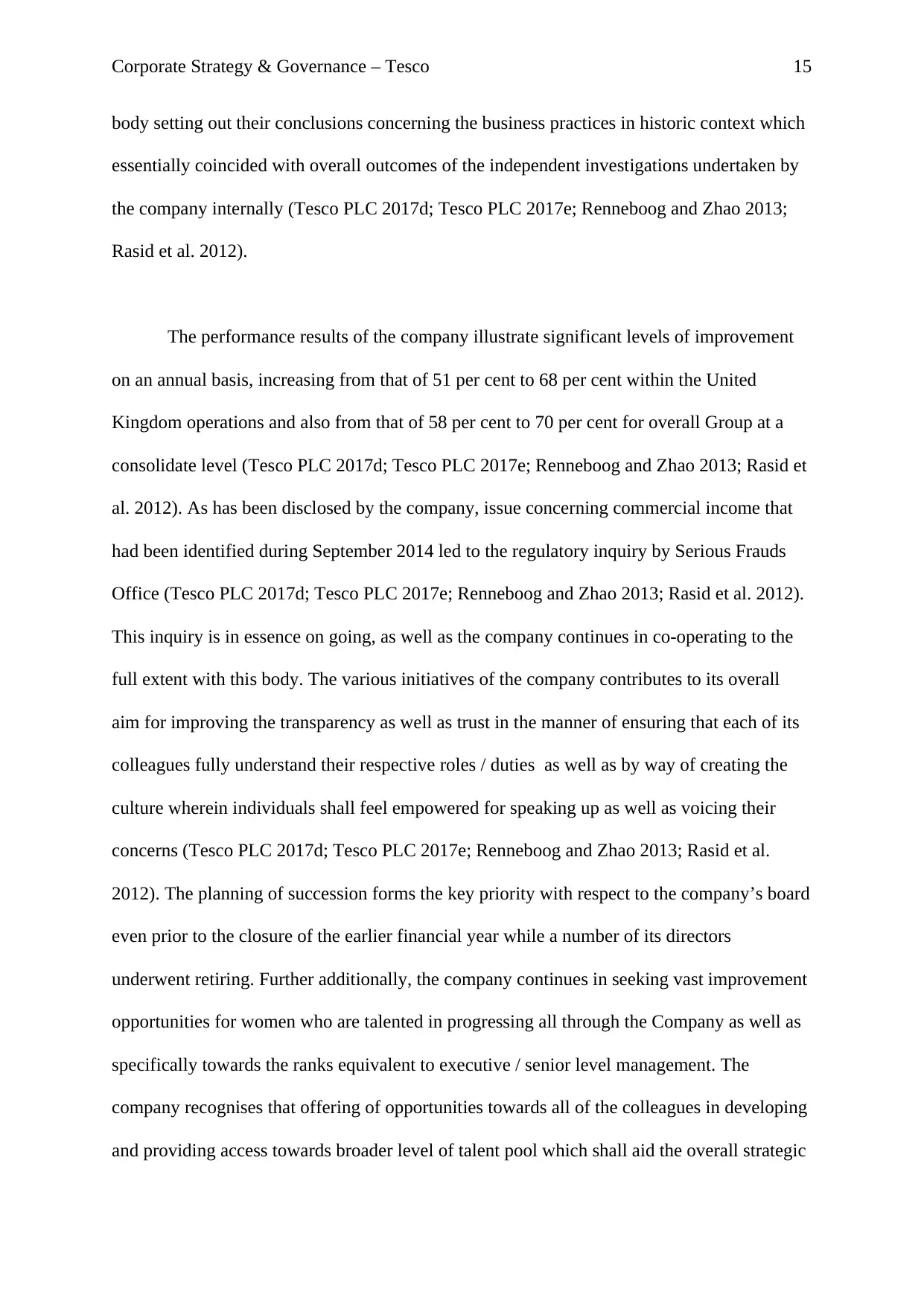
Corporate Strategy & Governance – Tesco 15
body setting out their conclusions concerning the business practices in historic context which
essentially coincided with overall outcomes of the independent investigations undertaken by
the company internally (Tesco PLC 2017d; Tesco PLC 2017e; Renneboog and Zhao 2013;
Rasid et al. 2012).
The performance results of the company illustrate significant levels of improvement
on an annual basis, increasing from that of 51 per cent to 68 per cent within the United
Kingdom operations and also from that of 58 per cent to 70 per cent for overall Group at a
consolidate level (Tesco PLC 2017d; Tesco PLC 2017e; Renneboog and Zhao 2013; Rasid et
al. 2012). As has been disclosed by the company, issue concerning commercial income that
had been identified during September 2014 led to the regulatory inquiry by Serious Frauds
Office (Tesco PLC 2017d; Tesco PLC 2017e; Renneboog and Zhao 2013; Rasid et al. 2012).
This inquiry is in essence on going, as well as the company continues in co-operating to the
full extent with this body. The various initiatives of the company contributes to its overall
aim for improving the transparency as well as trust in the manner of ensuring that each of its
colleagues fully understand their respective roles / duties as well as by way of creating the
culture wherein individuals shall feel empowered for speaking up as well as voicing their
concerns (Tesco PLC 2017d; Tesco PLC 2017e; Renneboog and Zhao 2013; Rasid et al.
2012). The planning of succession forms the key priority with respect to the company’s board
even prior to the closure of the earlier financial year while a number of its directors
underwent retiring. Further additionally, the company continues in seeking vast improvement
opportunities for women who are talented in progressing all through the Company as well as
specifically towards the ranks equivalent to executive / senior level management. The
company recognises that offering of opportunities towards all of the colleagues in developing
and providing access towards broader level of talent pool which shall aid the overall strategic
body setting out their conclusions concerning the business practices in historic context which
essentially coincided with overall outcomes of the independent investigations undertaken by
the company internally (Tesco PLC 2017d; Tesco PLC 2017e; Renneboog and Zhao 2013;
Rasid et al. 2012).
The performance results of the company illustrate significant levels of improvement
on an annual basis, increasing from that of 51 per cent to 68 per cent within the United
Kingdom operations and also from that of 58 per cent to 70 per cent for overall Group at a
consolidate level (Tesco PLC 2017d; Tesco PLC 2017e; Renneboog and Zhao 2013; Rasid et
al. 2012). As has been disclosed by the company, issue concerning commercial income that
had been identified during September 2014 led to the regulatory inquiry by Serious Frauds
Office (Tesco PLC 2017d; Tesco PLC 2017e; Renneboog and Zhao 2013; Rasid et al. 2012).
This inquiry is in essence on going, as well as the company continues in co-operating to the
full extent with this body. The various initiatives of the company contributes to its overall
aim for improving the transparency as well as trust in the manner of ensuring that each of its
colleagues fully understand their respective roles / duties as well as by way of creating the
culture wherein individuals shall feel empowered for speaking up as well as voicing their
concerns (Tesco PLC 2017d; Tesco PLC 2017e; Renneboog and Zhao 2013; Rasid et al.
2012). The planning of succession forms the key priority with respect to the company’s board
even prior to the closure of the earlier financial year while a number of its directors
underwent retiring. Further additionally, the company continues in seeking vast improvement
opportunities for women who are talented in progressing all through the Company as well as
specifically towards the ranks equivalent to executive / senior level management. The
company recognises that offering of opportunities towards all of the colleagues in developing
and providing access towards broader level of talent pool which shall aid the overall strategic

Corporate Strategy & Governance – Tesco 16
focus for regaining its competitiveness (Tesco PLC 2017d; Tesco PLC 2017e; Renneboog
and Zhao 2013; Rasid et al. 2012).
Board Crisis Action Plan
In the context of Tesco PLC let us assume that the company faces a natural disaster of
catastrophic proportion like a once in 500 year flood situation that is critical endangering its
assets as well as people. The crisis action plan undertaken by its board shall be as follows,
Defining the Principles, Priorities and Purpose: Starting the action plan with suitable
explanation for how and why this crisis / disaster plan shall be relevant for the
organization, the overall mission, as well as the people who are being served (Blaikie
et al. 2014; Frigo and Anderson 2011). The same communicates overall
organizational commitment for addressing this crisis situation in a manner that is
efficient and focused (Blaikie et al. 2014; Frigo and Anderson 2011).
Designating Response Team: A response team shall provide overall structure,
establishing the requisite principles, and also implementing the applicable policies to
undertake action within overall events of the emergency (Maldonado and Vera 2014;
Van den Berghe 2012). This plan shall describe the roles / responsibilities concerning
team members as well as offering the contact information that is up to date
(Maldonado and Vera 2014; Van den Berghe 2012).
Assessing the Risks by way of Varied Forms of Disasters / Crises: Any event shall
occur which can be either internal or external for this organization as well as both
shall have impact of serious nature over the organization (Spence et al. 2015;
Wheelen and Hunger 2011). By taking in consideration the relevant program,
community as well as the focus shall lay on defining as well as prioritizing the
focus for regaining its competitiveness (Tesco PLC 2017d; Tesco PLC 2017e; Renneboog
and Zhao 2013; Rasid et al. 2012).
Board Crisis Action Plan
In the context of Tesco PLC let us assume that the company faces a natural disaster of
catastrophic proportion like a once in 500 year flood situation that is critical endangering its
assets as well as people. The crisis action plan undertaken by its board shall be as follows,
Defining the Principles, Priorities and Purpose: Starting the action plan with suitable
explanation for how and why this crisis / disaster plan shall be relevant for the
organization, the overall mission, as well as the people who are being served (Blaikie
et al. 2014; Frigo and Anderson 2011). The same communicates overall
organizational commitment for addressing this crisis situation in a manner that is
efficient and focused (Blaikie et al. 2014; Frigo and Anderson 2011).
Designating Response Team: A response team shall provide overall structure,
establishing the requisite principles, and also implementing the applicable policies to
undertake action within overall events of the emergency (Maldonado and Vera 2014;
Van den Berghe 2012). This plan shall describe the roles / responsibilities concerning
team members as well as offering the contact information that is up to date
(Maldonado and Vera 2014; Van den Berghe 2012).
Assessing the Risks by way of Varied Forms of Disasters / Crises: Any event shall
occur which can be either internal or external for this organization as well as both
shall have impact of serious nature over the organization (Spence et al. 2015;
Wheelen and Hunger 2011). By taking in consideration the relevant program,
community as well as the focus shall lay on defining as well as prioritizing the
Secure Best Marks with AI Grader
Need help grading? Try our AI Grader for instant feedback on your assignments.

Corporate Strategy & Governance – Tesco 17
applicable risks which shall be most relevant in the specific case (Spence et al. 2015;
Wheelen and Hunger 2011).
Development of the Plan for Business Continuity: The planning for business
continuity shall address following domains, (i) preparation, that is, actions that are
taken before the actual disaster or crisis, (ii) response, that is, steps as well as
procedures which are done immediately post the interruption or emergency towards
the concerned business, (iii) restoration / recovery, that is, the steps undertaken for
restoring the functionality such that certain levels of the services could be offered for
the clients when restoring the company to the original status before to the interruption
(Yeager and Roberts 2015; Chait et al. 2011). In essence, business continuity plan
forms the critical tool and the development of the same shall rely over various set of
factors, encompassing, yet not restricted to overall mission of this organization,
various services delivered, as well as individuals being served (Yeager and Roberts
2015; Chait et al. 2011).
The Integrated System Approach: With the development of the action plan being
undertaken, it shall become likely that one will start to note the interconnections
amongst crisis as well as planning of disaster and also plans for operations,
procedures and policies which the organizations have in place at the times of non-
disasters. In certain instances, stronger systems could reduce the overall impacts
concerning the relevant crisis situation (Checchi et al. 2017; Bain and Band 2016).
The system that is well-functioning as well as established could aid in leading to
quicker responses as well as easing of anxieties and tensions concerning the events
that are unexpected. The overall development concerning the plans for disaster and
crisis need to encompass the review comprising each of the affiliated procedures,
plans as well as systems (Checchi et al. 2017; Bain and Band 2016).
applicable risks which shall be most relevant in the specific case (Spence et al. 2015;
Wheelen and Hunger 2011).
Development of the Plan for Business Continuity: The planning for business
continuity shall address following domains, (i) preparation, that is, actions that are
taken before the actual disaster or crisis, (ii) response, that is, steps as well as
procedures which are done immediately post the interruption or emergency towards
the concerned business, (iii) restoration / recovery, that is, the steps undertaken for
restoring the functionality such that certain levels of the services could be offered for
the clients when restoring the company to the original status before to the interruption
(Yeager and Roberts 2015; Chait et al. 2011). In essence, business continuity plan
forms the critical tool and the development of the same shall rely over various set of
factors, encompassing, yet not restricted to overall mission of this organization,
various services delivered, as well as individuals being served (Yeager and Roberts
2015; Chait et al. 2011).
The Integrated System Approach: With the development of the action plan being
undertaken, it shall become likely that one will start to note the interconnections
amongst crisis as well as planning of disaster and also plans for operations,
procedures and policies which the organizations have in place at the times of non-
disasters. In certain instances, stronger systems could reduce the overall impacts
concerning the relevant crisis situation (Checchi et al. 2017; Bain and Band 2016).
The system that is well-functioning as well as established could aid in leading to
quicker responses as well as easing of anxieties and tensions concerning the events
that are unexpected. The overall development concerning the plans for disaster and
crisis need to encompass the review comprising each of the affiliated procedures,
plans as well as systems (Checchi et al. 2017; Bain and Band 2016).
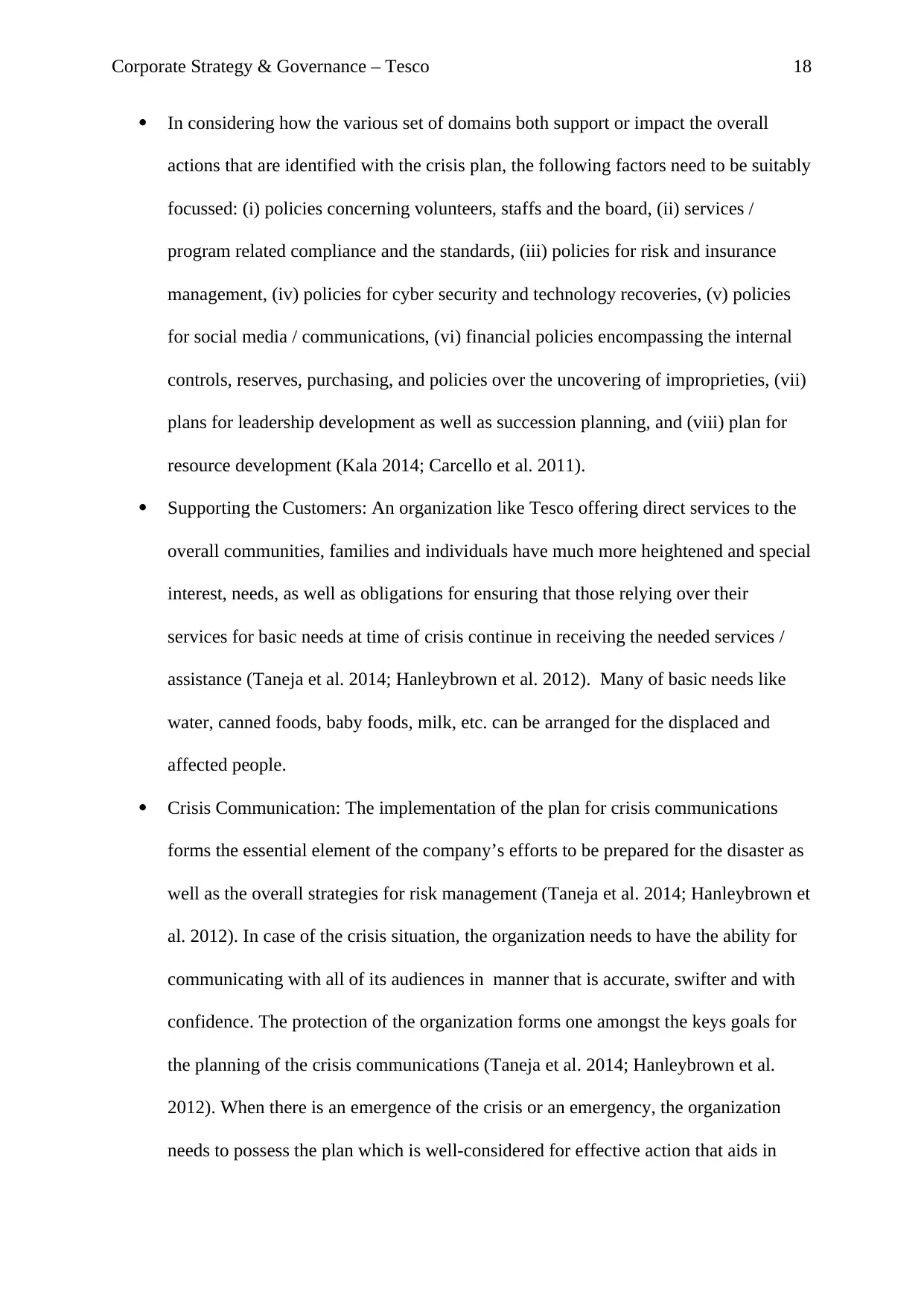
Corporate Strategy & Governance – Tesco 18
In considering how the various set of domains both support or impact the overall
actions that are identified with the crisis plan, the following factors need to be suitably
focussed: (i) policies concerning volunteers, staffs and the board, (ii) services /
program related compliance and the standards, (iii) policies for risk and insurance
management, (iv) policies for cyber security and technology recoveries, (v) policies
for social media / communications, (vi) financial policies encompassing the internal
controls, reserves, purchasing, and policies over the uncovering of improprieties, (vii)
plans for leadership development as well as succession planning, and (viii) plan for
resource development (Kala 2014; Carcello et al. 2011).
Supporting the Customers: An organization like Tesco offering direct services to the
overall communities, families and individuals have much more heightened and special
interest, needs, as well as obligations for ensuring that those relying over their
services for basic needs at time of crisis continue in receiving the needed services /
assistance (Taneja et al. 2014; Hanleybrown et al. 2012). Many of basic needs like
water, canned foods, baby foods, milk, etc. can be arranged for the displaced and
affected people.
Crisis Communication: The implementation of the plan for crisis communications
forms the essential element of the company’s efforts to be prepared for the disaster as
well as the overall strategies for risk management (Taneja et al. 2014; Hanleybrown et
al. 2012). In case of the crisis situation, the organization needs to have the ability for
communicating with all of its audiences in manner that is accurate, swifter and with
confidence. The protection of the organization forms one amongst the keys goals for
the planning of the crisis communications (Taneja et al. 2014; Hanleybrown et al.
2012). When there is an emergence of the crisis or an emergency, the organization
needs to possess the plan which is well-considered for effective action that aids in
In considering how the various set of domains both support or impact the overall
actions that are identified with the crisis plan, the following factors need to be suitably
focussed: (i) policies concerning volunteers, staffs and the board, (ii) services /
program related compliance and the standards, (iii) policies for risk and insurance
management, (iv) policies for cyber security and technology recoveries, (v) policies
for social media / communications, (vi) financial policies encompassing the internal
controls, reserves, purchasing, and policies over the uncovering of improprieties, (vii)
plans for leadership development as well as succession planning, and (viii) plan for
resource development (Kala 2014; Carcello et al. 2011).
Supporting the Customers: An organization like Tesco offering direct services to the
overall communities, families and individuals have much more heightened and special
interest, needs, as well as obligations for ensuring that those relying over their
services for basic needs at time of crisis continue in receiving the needed services /
assistance (Taneja et al. 2014; Hanleybrown et al. 2012). Many of basic needs like
water, canned foods, baby foods, milk, etc. can be arranged for the displaced and
affected people.
Crisis Communication: The implementation of the plan for crisis communications
forms the essential element of the company’s efforts to be prepared for the disaster as
well as the overall strategies for risk management (Taneja et al. 2014; Hanleybrown et
al. 2012). In case of the crisis situation, the organization needs to have the ability for
communicating with all of its audiences in manner that is accurate, swifter and with
confidence. The protection of the organization forms one amongst the keys goals for
the planning of the crisis communications (Taneja et al. 2014; Hanleybrown et al.
2012). When there is an emergence of the crisis or an emergency, the organization
needs to possess the plan which is well-considered for effective action that aids in
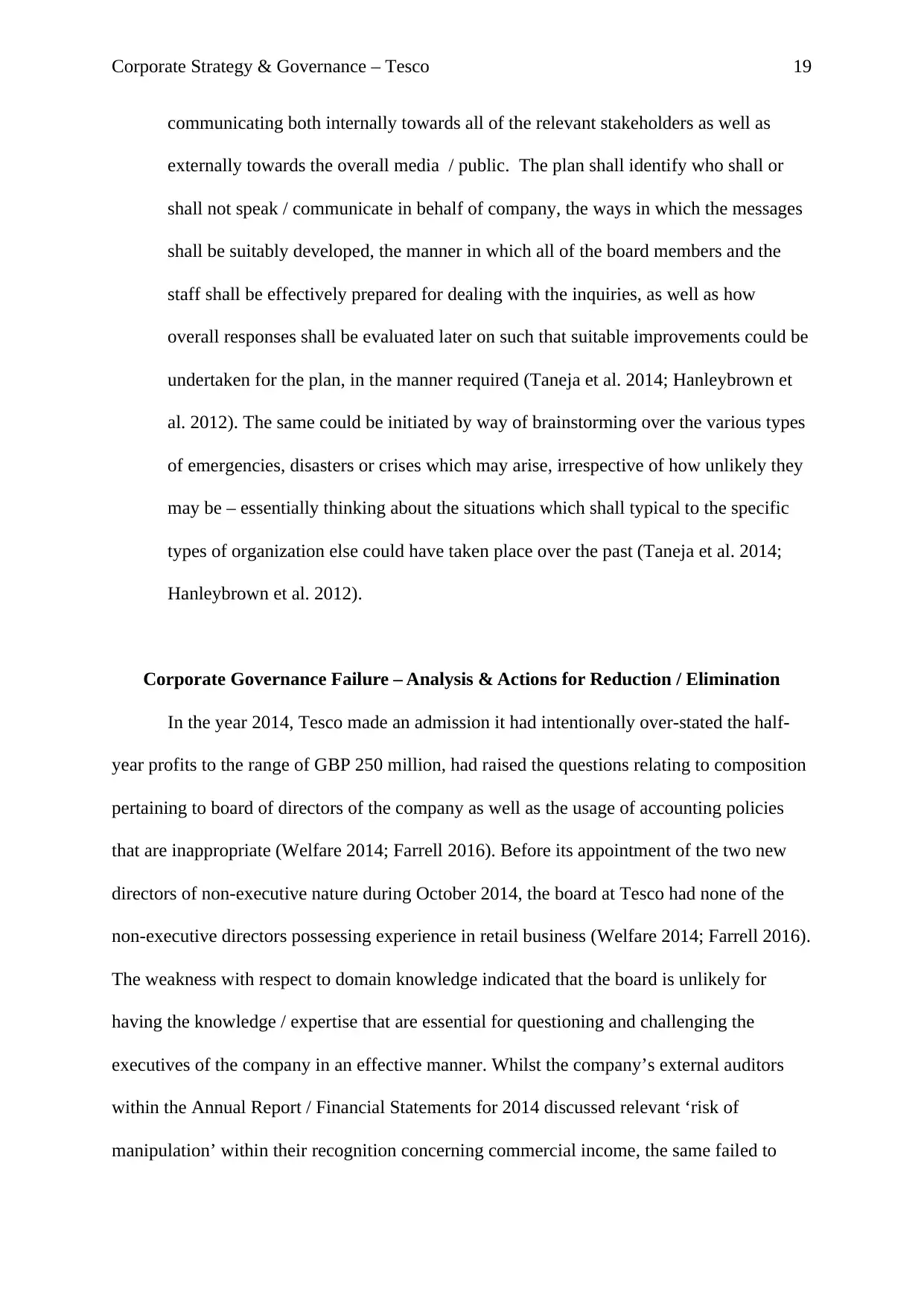
Corporate Strategy & Governance – Tesco 19
communicating both internally towards all of the relevant stakeholders as well as
externally towards the overall media / public. The plan shall identify who shall or
shall not speak / communicate in behalf of company, the ways in which the messages
shall be suitably developed, the manner in which all of the board members and the
staff shall be effectively prepared for dealing with the inquiries, as well as how
overall responses shall be evaluated later on such that suitable improvements could be
undertaken for the plan, in the manner required (Taneja et al. 2014; Hanleybrown et
al. 2012). The same could be initiated by way of brainstorming over the various types
of emergencies, disasters or crises which may arise, irrespective of how unlikely they
may be – essentially thinking about the situations which shall typical to the specific
types of organization else could have taken place over the past (Taneja et al. 2014;
Hanleybrown et al. 2012).
Corporate Governance Failure – Analysis & Actions for Reduction / Elimination
In the year 2014, Tesco made an admission it had intentionally over-stated the half-
year profits to the range of GBP 250 million, had raised the questions relating to composition
pertaining to board of directors of the company as well as the usage of accounting policies
that are inappropriate (Welfare 2014; Farrell 2016). Before its appointment of the two new
directors of non-executive nature during October 2014, the board at Tesco had none of the
non-executive directors possessing experience in retail business (Welfare 2014; Farrell 2016).
The weakness with respect to domain knowledge indicated that the board is unlikely for
having the knowledge / expertise that are essential for questioning and challenging the
executives of the company in an effective manner. Whilst the company’s external auditors
within the Annual Report / Financial Statements for 2014 discussed relevant ‘risk of
manipulation’ within their recognition concerning commercial income, the same failed to
communicating both internally towards all of the relevant stakeholders as well as
externally towards the overall media / public. The plan shall identify who shall or
shall not speak / communicate in behalf of company, the ways in which the messages
shall be suitably developed, the manner in which all of the board members and the
staff shall be effectively prepared for dealing with the inquiries, as well as how
overall responses shall be evaluated later on such that suitable improvements could be
undertaken for the plan, in the manner required (Taneja et al. 2014; Hanleybrown et
al. 2012). The same could be initiated by way of brainstorming over the various types
of emergencies, disasters or crises which may arise, irrespective of how unlikely they
may be – essentially thinking about the situations which shall typical to the specific
types of organization else could have taken place over the past (Taneja et al. 2014;
Hanleybrown et al. 2012).
Corporate Governance Failure – Analysis & Actions for Reduction / Elimination
In the year 2014, Tesco made an admission it had intentionally over-stated the half-
year profits to the range of GBP 250 million, had raised the questions relating to composition
pertaining to board of directors of the company as well as the usage of accounting policies
that are inappropriate (Welfare 2014; Farrell 2016). Before its appointment of the two new
directors of non-executive nature during October 2014, the board at Tesco had none of the
non-executive directors possessing experience in retail business (Welfare 2014; Farrell 2016).
The weakness with respect to domain knowledge indicated that the board is unlikely for
having the knowledge / expertise that are essential for questioning and challenging the
executives of the company in an effective manner. Whilst the company’s external auditors
within the Annual Report / Financial Statements for 2014 discussed relevant ‘risk of
manipulation’ within their recognition concerning commercial income, the same failed to
Paraphrase This Document
Need a fresh take? Get an instant paraphrase of this document with our AI Paraphraser
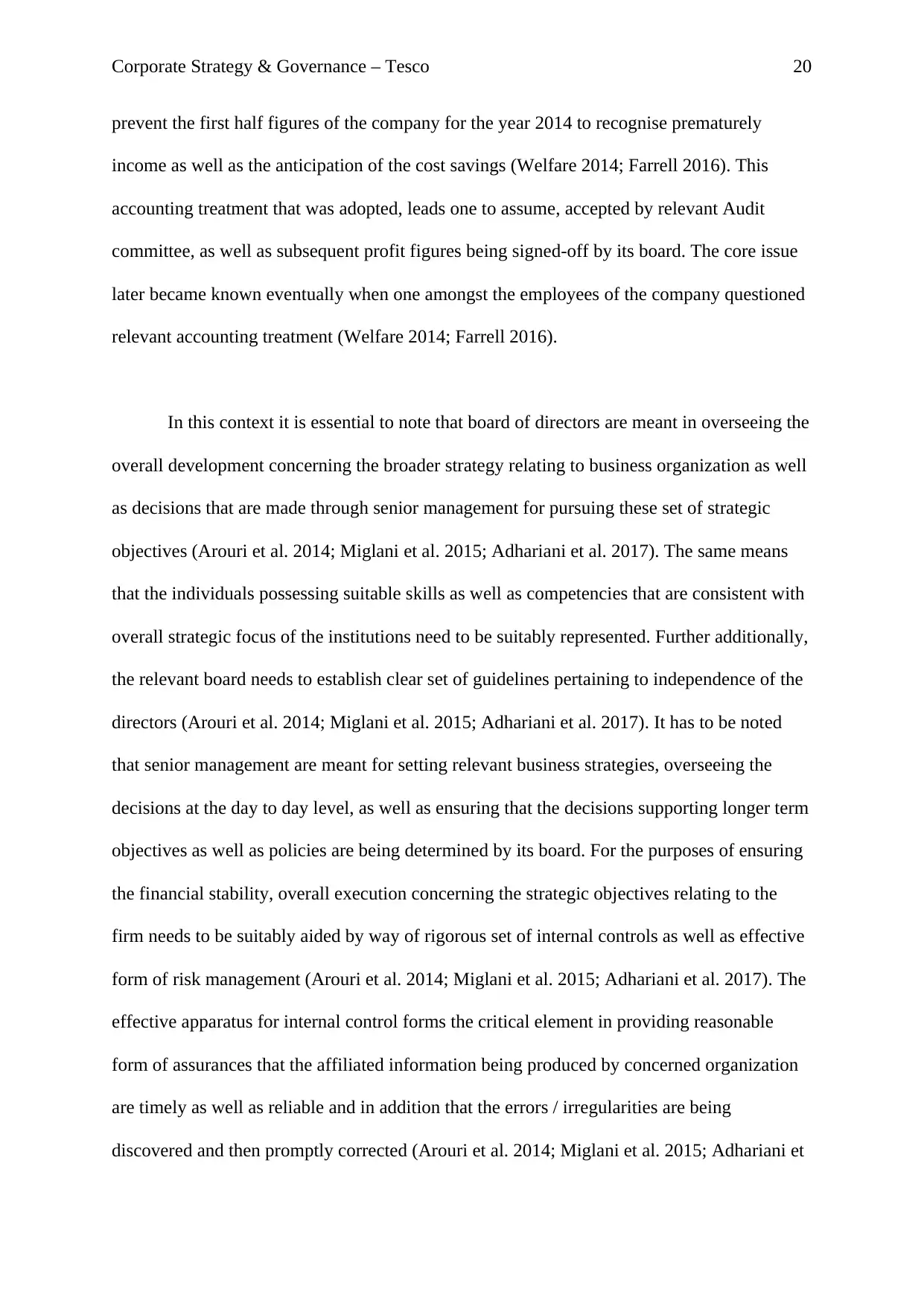
Corporate Strategy & Governance – Tesco 20
prevent the first half figures of the company for the year 2014 to recognise prematurely
income as well as the anticipation of the cost savings (Welfare 2014; Farrell 2016). This
accounting treatment that was adopted, leads one to assume, accepted by relevant Audit
committee, as well as subsequent profit figures being signed-off by its board. The core issue
later became known eventually when one amongst the employees of the company questioned
relevant accounting treatment (Welfare 2014; Farrell 2016).
In this context it is essential to note that board of directors are meant in overseeing the
overall development concerning the broader strategy relating to business organization as well
as decisions that are made through senior management for pursuing these set of strategic
objectives (Arouri et al. 2014; Miglani et al. 2015; Adhariani et al. 2017). The same means
that the individuals possessing suitable skills as well as competencies that are consistent with
overall strategic focus of the institutions need to be suitably represented. Further additionally,
the relevant board needs to establish clear set of guidelines pertaining to independence of the
directors (Arouri et al. 2014; Miglani et al. 2015; Adhariani et al. 2017). It has to be noted
that senior management are meant for setting relevant business strategies, overseeing the
decisions at the day to day level, as well as ensuring that the decisions supporting longer term
objectives as well as policies are being determined by its board. For the purposes of ensuring
the financial stability, overall execution concerning the strategic objectives relating to the
firm needs to be suitably aided by way of rigorous set of internal controls as well as effective
form of risk management (Arouri et al. 2014; Miglani et al. 2015; Adhariani et al. 2017). The
effective apparatus for internal control forms the critical element in providing reasonable
form of assurances that the affiliated information being produced by concerned organization
are timely as well as reliable and in addition that the errors / irregularities are being
discovered and then promptly corrected (Arouri et al. 2014; Miglani et al. 2015; Adhariani et
prevent the first half figures of the company for the year 2014 to recognise prematurely
income as well as the anticipation of the cost savings (Welfare 2014; Farrell 2016). This
accounting treatment that was adopted, leads one to assume, accepted by relevant Audit
committee, as well as subsequent profit figures being signed-off by its board. The core issue
later became known eventually when one amongst the employees of the company questioned
relevant accounting treatment (Welfare 2014; Farrell 2016).
In this context it is essential to note that board of directors are meant in overseeing the
overall development concerning the broader strategy relating to business organization as well
as decisions that are made through senior management for pursuing these set of strategic
objectives (Arouri et al. 2014; Miglani et al. 2015; Adhariani et al. 2017). The same means
that the individuals possessing suitable skills as well as competencies that are consistent with
overall strategic focus of the institutions need to be suitably represented. Further additionally,
the relevant board needs to establish clear set of guidelines pertaining to independence of the
directors (Arouri et al. 2014; Miglani et al. 2015; Adhariani et al. 2017). It has to be noted
that senior management are meant for setting relevant business strategies, overseeing the
decisions at the day to day level, as well as ensuring that the decisions supporting longer term
objectives as well as policies are being determined by its board. For the purposes of ensuring
the financial stability, overall execution concerning the strategic objectives relating to the
firm needs to be suitably aided by way of rigorous set of internal controls as well as effective
form of risk management (Arouri et al. 2014; Miglani et al. 2015; Adhariani et al. 2017). The
effective apparatus for internal control forms the critical element in providing reasonable
form of assurances that the affiliated information being produced by concerned organization
are timely as well as reliable and in addition that the errors / irregularities are being
discovered and then promptly corrected (Arouri et al. 2014; Miglani et al. 2015; Adhariani et
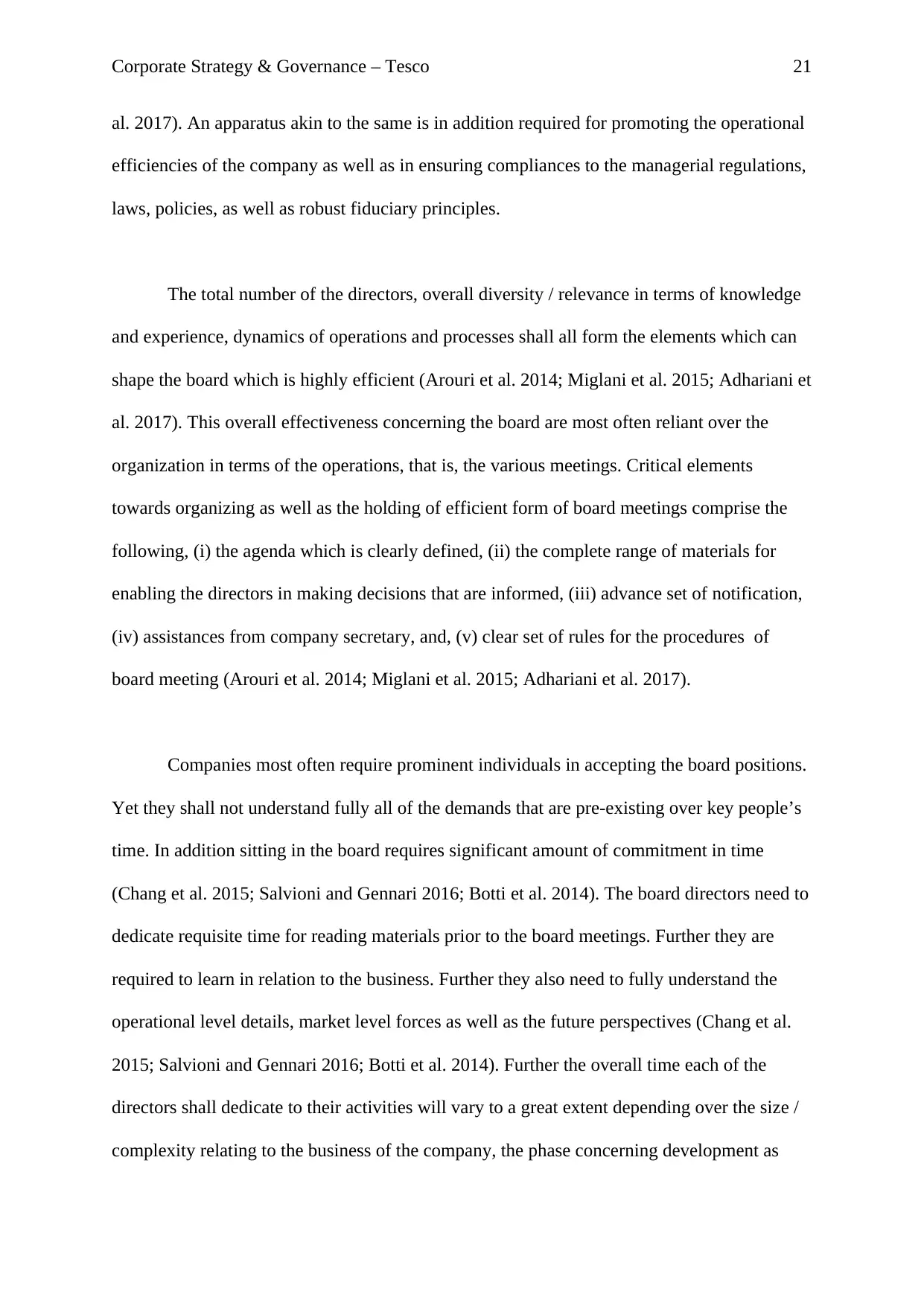
Corporate Strategy & Governance – Tesco 21
al. 2017). An apparatus akin to the same is in addition required for promoting the operational
efficiencies of the company as well as in ensuring compliances to the managerial regulations,
laws, policies, as well as robust fiduciary principles.
The total number of the directors, overall diversity / relevance in terms of knowledge
and experience, dynamics of operations and processes shall all form the elements which can
shape the board which is highly efficient (Arouri et al. 2014; Miglani et al. 2015; Adhariani et
al. 2017). This overall effectiveness concerning the board are most often reliant over the
organization in terms of the operations, that is, the various meetings. Critical elements
towards organizing as well as the holding of efficient form of board meetings comprise the
following, (i) the agenda which is clearly defined, (ii) the complete range of materials for
enabling the directors in making decisions that are informed, (iii) advance set of notification,
(iv) assistances from company secretary, and, (v) clear set of rules for the procedures of
board meeting (Arouri et al. 2014; Miglani et al. 2015; Adhariani et al. 2017).
Companies most often require prominent individuals in accepting the board positions.
Yet they shall not understand fully all of the demands that are pre-existing over key people’s
time. In addition sitting in the board requires significant amount of commitment in time
(Chang et al. 2015; Salvioni and Gennari 2016; Botti et al. 2014). The board directors need to
dedicate requisite time for reading materials prior to the board meetings. Further they are
required to learn in relation to the business. Further they also need to fully understand the
operational level details, market level forces as well as the future perspectives (Chang et al.
2015; Salvioni and Gennari 2016; Botti et al. 2014). Further the overall time each of the
directors shall dedicate to their activities will vary to a great extent depending over the size /
complexity relating to the business of the company, the phase concerning development as
al. 2017). An apparatus akin to the same is in addition required for promoting the operational
efficiencies of the company as well as in ensuring compliances to the managerial regulations,
laws, policies, as well as robust fiduciary principles.
The total number of the directors, overall diversity / relevance in terms of knowledge
and experience, dynamics of operations and processes shall all form the elements which can
shape the board which is highly efficient (Arouri et al. 2014; Miglani et al. 2015; Adhariani et
al. 2017). This overall effectiveness concerning the board are most often reliant over the
organization in terms of the operations, that is, the various meetings. Critical elements
towards organizing as well as the holding of efficient form of board meetings comprise the
following, (i) the agenda which is clearly defined, (ii) the complete range of materials for
enabling the directors in making decisions that are informed, (iii) advance set of notification,
(iv) assistances from company secretary, and, (v) clear set of rules for the procedures of
board meeting (Arouri et al. 2014; Miglani et al. 2015; Adhariani et al. 2017).
Companies most often require prominent individuals in accepting the board positions.
Yet they shall not understand fully all of the demands that are pre-existing over key people’s
time. In addition sitting in the board requires significant amount of commitment in time
(Chang et al. 2015; Salvioni and Gennari 2016; Botti et al. 2014). The board directors need to
dedicate requisite time for reading materials prior to the board meetings. Further they are
required to learn in relation to the business. Further they also need to fully understand the
operational level details, market level forces as well as the future perspectives (Chang et al.
2015; Salvioni and Gennari 2016; Botti et al. 2014). Further the overall time each of the
directors shall dedicate to their activities will vary to a great extent depending over the size /
complexity relating to the business of the company, the phase concerning development as
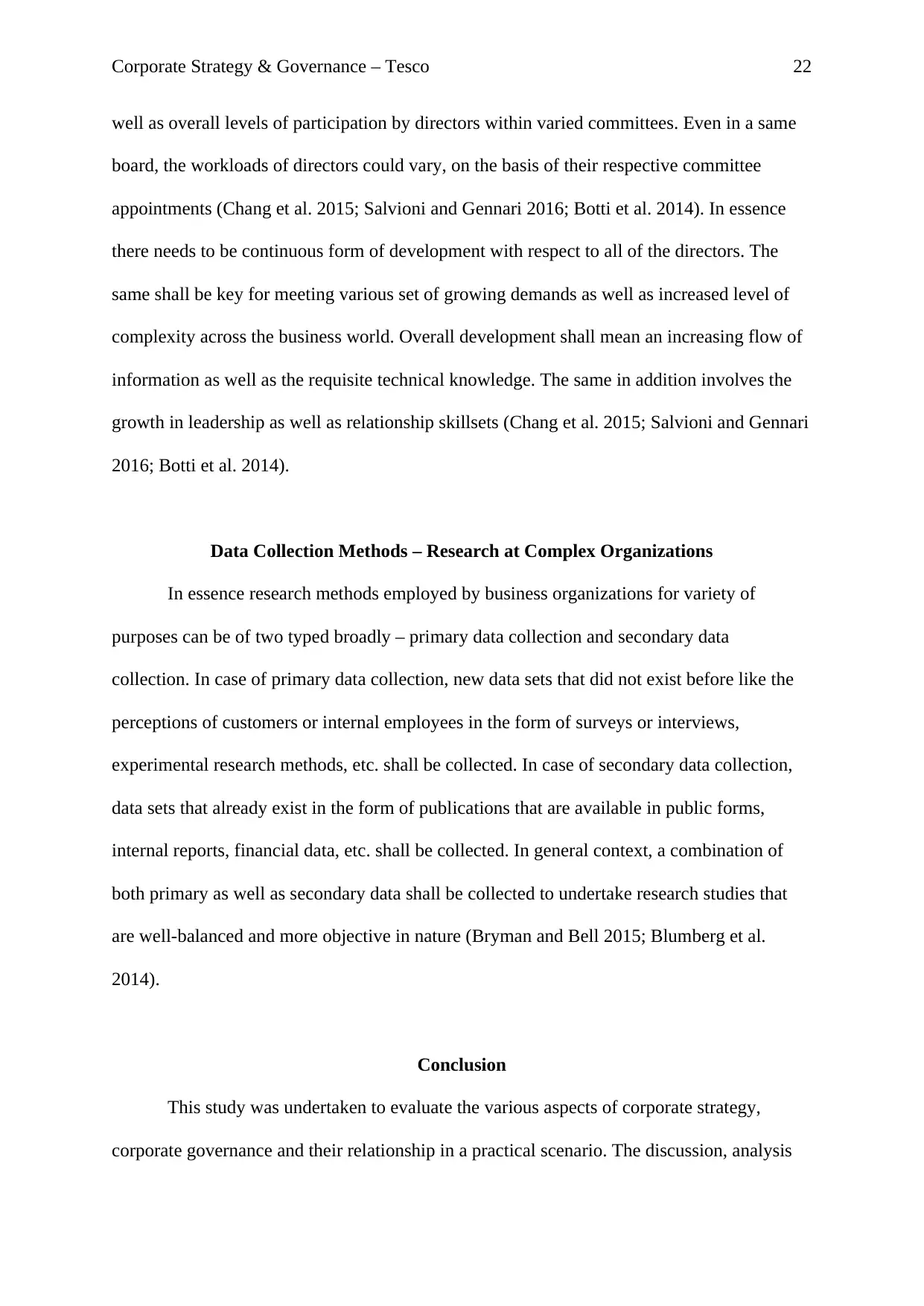
Corporate Strategy & Governance – Tesco 22
well as overall levels of participation by directors within varied committees. Even in a same
board, the workloads of directors could vary, on the basis of their respective committee
appointments (Chang et al. 2015; Salvioni and Gennari 2016; Botti et al. 2014). In essence
there needs to be continuous form of development with respect to all of the directors. The
same shall be key for meeting various set of growing demands as well as increased level of
complexity across the business world. Overall development shall mean an increasing flow of
information as well as the requisite technical knowledge. The same in addition involves the
growth in leadership as well as relationship skillsets (Chang et al. 2015; Salvioni and Gennari
2016; Botti et al. 2014).
Data Collection Methods – Research at Complex Organizations
In essence research methods employed by business organizations for variety of
purposes can be of two typed broadly – primary data collection and secondary data
collection. In case of primary data collection, new data sets that did not exist before like the
perceptions of customers or internal employees in the form of surveys or interviews,
experimental research methods, etc. shall be collected. In case of secondary data collection,
data sets that already exist in the form of publications that are available in public forms,
internal reports, financial data, etc. shall be collected. In general context, a combination of
both primary as well as secondary data shall be collected to undertake research studies that
are well-balanced and more objective in nature (Bryman and Bell 2015; Blumberg et al.
2014).
Conclusion
This study was undertaken to evaluate the various aspects of corporate strategy,
corporate governance and their relationship in a practical scenario. The discussion, analysis
well as overall levels of participation by directors within varied committees. Even in a same
board, the workloads of directors could vary, on the basis of their respective committee
appointments (Chang et al. 2015; Salvioni and Gennari 2016; Botti et al. 2014). In essence
there needs to be continuous form of development with respect to all of the directors. The
same shall be key for meeting various set of growing demands as well as increased level of
complexity across the business world. Overall development shall mean an increasing flow of
information as well as the requisite technical knowledge. The same in addition involves the
growth in leadership as well as relationship skillsets (Chang et al. 2015; Salvioni and Gennari
2016; Botti et al. 2014).
Data Collection Methods – Research at Complex Organizations
In essence research methods employed by business organizations for variety of
purposes can be of two typed broadly – primary data collection and secondary data
collection. In case of primary data collection, new data sets that did not exist before like the
perceptions of customers or internal employees in the form of surveys or interviews,
experimental research methods, etc. shall be collected. In case of secondary data collection,
data sets that already exist in the form of publications that are available in public forms,
internal reports, financial data, etc. shall be collected. In general context, a combination of
both primary as well as secondary data shall be collected to undertake research studies that
are well-balanced and more objective in nature (Bryman and Bell 2015; Blumberg et al.
2014).
Conclusion
This study was undertaken to evaluate the various aspects of corporate strategy,
corporate governance and their relationship in a practical scenario. The discussion, analysis
Secure Best Marks with AI Grader
Need help grading? Try our AI Grader for instant feedback on your assignments.
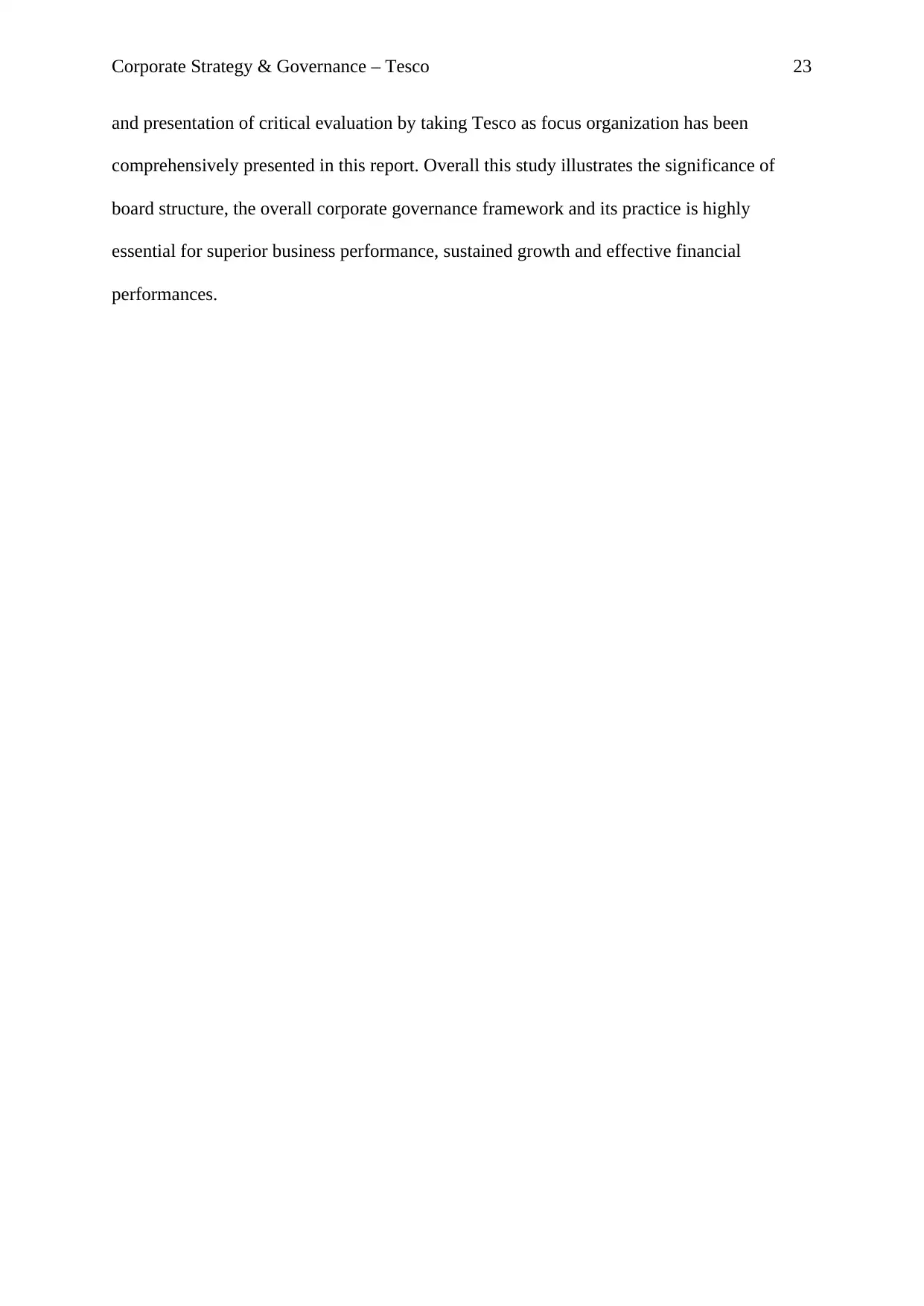
Corporate Strategy & Governance – Tesco 23
and presentation of critical evaluation by taking Tesco as focus organization has been
comprehensively presented in this report. Overall this study illustrates the significance of
board structure, the overall corporate governance framework and its practice is highly
essential for superior business performance, sustained growth and effective financial
performances.
and presentation of critical evaluation by taking Tesco as focus organization has been
comprehensively presented in this report. Overall this study illustrates the significance of
board structure, the overall corporate governance framework and its practice is highly
essential for superior business performance, sustained growth and effective financial
performances.

Corporate Strategy & Governance – Tesco 24
References
Adhariani, D., Sciulli, N. and Clift, R., 2017. Corporate Governance Practices from the Ethics
of Care Perspective. In Financial Management and Corporate Governance from the Feminist
Ethics of Care Perspective (pp. 49-80). Springer International Publishing.
Arouri, H., Hossain, M. and Badrul Muttakin, M., 2014. Effects of board and ownership
structure on corporate performance: Evidence from GCC countries. Journal of Accounting in
Emerging Economies, 4(1), pp.117-130.
Bain, N. and Band, D., 2016. Winning ways through corporate governance. Springer.
Blaikie, P., Cannon, T., Davis, I. and Wisner, B., 2014. At risk: natural hazards, people's
vulnerability and disasters. Routledge.
Blumberg, B.F., Cooper, D.R. and Schindler, P.S., 2014. Business research methods.
McGraw-hill education.
Botti, L., Boubaker, S., Hamrouni, A. and Solonandrasana, B., 2014. Corporate governance
efficiency and internet financial reporting quality. Review of Accounting and Finance, 13(1),
pp.43-64.
Bryman, A. and Bell, E., 2015. Business research methods. Oxford University Press, USA.
Carcello, J.V., Hermanson, D.R. and Ye, Z., 2011. Corporate governance research in
accounting and auditing: Insights, practice implications, and future research directions.
Auditing: A Journal of Practice & Theory, 30(3), pp.1-31.
Chait, R.P., Ryan, W.P. and Taylor, B.E., 2011. Governance as leadership: Reframing the
work of nonprofit boards. John Wiley & Sons.
Chang, C.S., Yu, S.W. and Hung, C.H., 2015. Firm risk and performance: the role of
corporate governance. Review of Managerial Science, 9(1), pp.141-173.
Checchi, F., Warsame, A., Treacy-Wong, V., Polonsky, J., van Ommeren, M. and Prudhon,
C., 2017. Public health information in crisis-affected populations: a review of methods and
their use for advocacy and action. The Lancet.
Davies, R.L. and Kirby, D.A., 2012. Retail organisation. Retail Geography (RLE Retailing
and Distribution), 7, p.156.
Farrell, S. 2016. Corporate governance: Tesco ranked lowest of FTSE 100 firms.
[online] Available at: https://www.theguardian.com/business/2016/sep/06/corporate-
governance-tesco-ranked-lowest-of-ftse-100-firms [Accessed on 29th August 2017]
Filatotchev, I. and Nakajima, C., 2014. Corporate governance, responsible managerial
behavior, and corporate social responsibility: organizational efficiency versus organizational
legitimacy?. The Academy of Management Perspectives, 28(3), pp.289-306.
References
Adhariani, D., Sciulli, N. and Clift, R., 2017. Corporate Governance Practices from the Ethics
of Care Perspective. In Financial Management and Corporate Governance from the Feminist
Ethics of Care Perspective (pp. 49-80). Springer International Publishing.
Arouri, H., Hossain, M. and Badrul Muttakin, M., 2014. Effects of board and ownership
structure on corporate performance: Evidence from GCC countries. Journal of Accounting in
Emerging Economies, 4(1), pp.117-130.
Bain, N. and Band, D., 2016. Winning ways through corporate governance. Springer.
Blaikie, P., Cannon, T., Davis, I. and Wisner, B., 2014. At risk: natural hazards, people's
vulnerability and disasters. Routledge.
Blumberg, B.F., Cooper, D.R. and Schindler, P.S., 2014. Business research methods.
McGraw-hill education.
Botti, L., Boubaker, S., Hamrouni, A. and Solonandrasana, B., 2014. Corporate governance
efficiency and internet financial reporting quality. Review of Accounting and Finance, 13(1),
pp.43-64.
Bryman, A. and Bell, E., 2015. Business research methods. Oxford University Press, USA.
Carcello, J.V., Hermanson, D.R. and Ye, Z., 2011. Corporate governance research in
accounting and auditing: Insights, practice implications, and future research directions.
Auditing: A Journal of Practice & Theory, 30(3), pp.1-31.
Chait, R.P., Ryan, W.P. and Taylor, B.E., 2011. Governance as leadership: Reframing the
work of nonprofit boards. John Wiley & Sons.
Chang, C.S., Yu, S.W. and Hung, C.H., 2015. Firm risk and performance: the role of
corporate governance. Review of Managerial Science, 9(1), pp.141-173.
Checchi, F., Warsame, A., Treacy-Wong, V., Polonsky, J., van Ommeren, M. and Prudhon,
C., 2017. Public health information in crisis-affected populations: a review of methods and
their use for advocacy and action. The Lancet.
Davies, R.L. and Kirby, D.A., 2012. Retail organisation. Retail Geography (RLE Retailing
and Distribution), 7, p.156.
Farrell, S. 2016. Corporate governance: Tesco ranked lowest of FTSE 100 firms.
[online] Available at: https://www.theguardian.com/business/2016/sep/06/corporate-
governance-tesco-ranked-lowest-of-ftse-100-firms [Accessed on 29th August 2017]
Filatotchev, I. and Nakajima, C., 2014. Corporate governance, responsible managerial
behavior, and corporate social responsibility: organizational efficiency versus organizational
legitimacy?. The Academy of Management Perspectives, 28(3), pp.289-306.
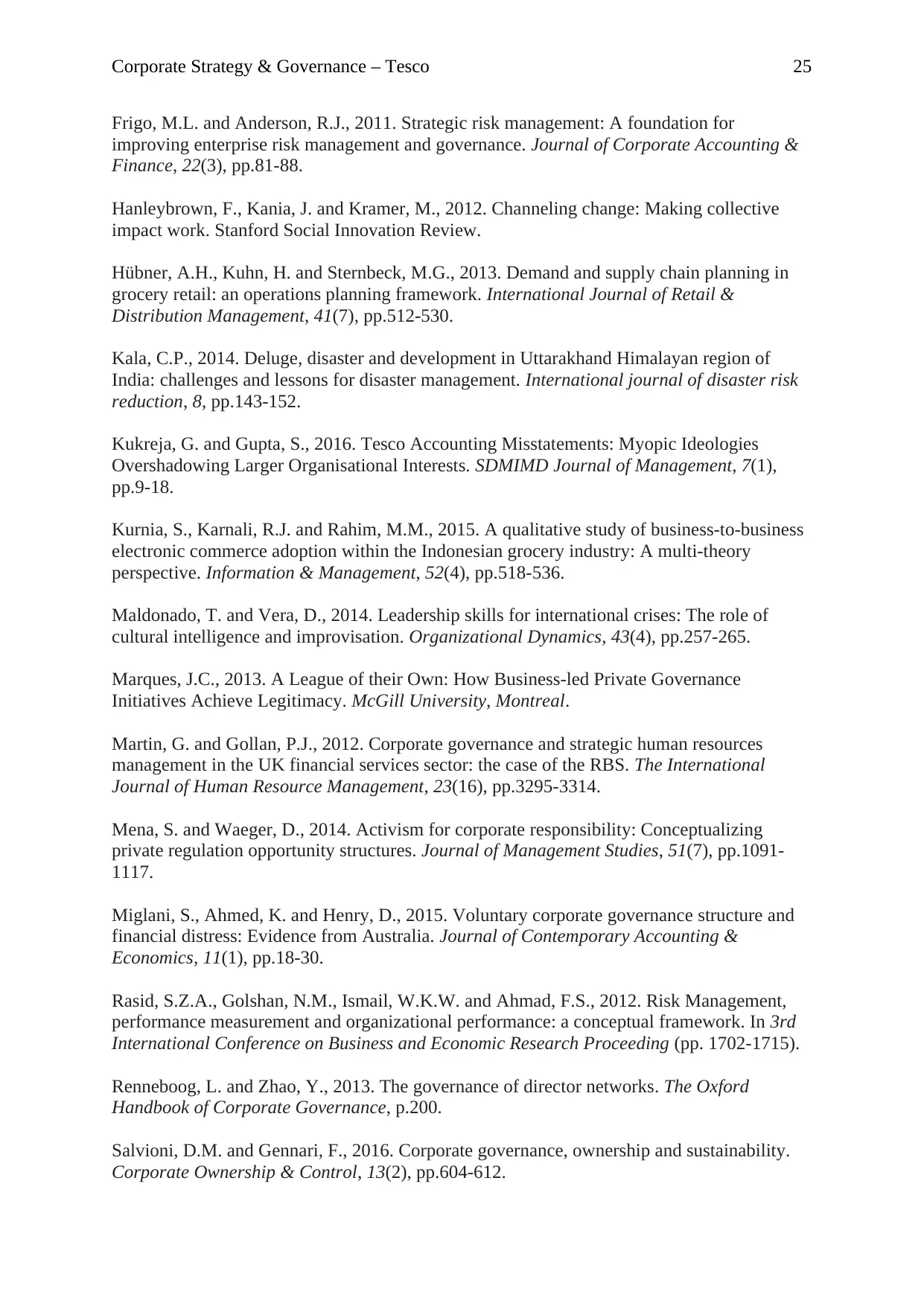
Corporate Strategy & Governance – Tesco 25
Frigo, M.L. and Anderson, R.J., 2011. Strategic risk management: A foundation for
improving enterprise risk management and governance. Journal of Corporate Accounting &
Finance, 22(3), pp.81-88.
Hanleybrown, F., Kania, J. and Kramer, M., 2012. Channeling change: Making collective
impact work. Stanford Social Innovation Review.
Hübner, A.H., Kuhn, H. and Sternbeck, M.G., 2013. Demand and supply chain planning in
grocery retail: an operations planning framework. International Journal of Retail &
Distribution Management, 41(7), pp.512-530.
Kala, C.P., 2014. Deluge, disaster and development in Uttarakhand Himalayan region of
India: challenges and lessons for disaster management. International journal of disaster risk
reduction, 8, pp.143-152.
Kukreja, G. and Gupta, S., 2016. Tesco Accounting Misstatements: Myopic Ideologies
Overshadowing Larger Organisational Interests. SDMIMD Journal of Management, 7(1),
pp.9-18.
Kurnia, S., Karnali, R.J. and Rahim, M.M., 2015. A qualitative study of business-to-business
electronic commerce adoption within the Indonesian grocery industry: A multi-theory
perspective. Information & Management, 52(4), pp.518-536.
Maldonado, T. and Vera, D., 2014. Leadership skills for international crises: The role of
cultural intelligence and improvisation. Organizational Dynamics, 43(4), pp.257-265.
Marques, J.C., 2013. A League of their Own: How Business-led Private Governance
Initiatives Achieve Legitimacy. McGill University, Montreal.
Martin, G. and Gollan, P.J., 2012. Corporate governance and strategic human resources
management in the UK financial services sector: the case of the RBS. The International
Journal of Human Resource Management, 23(16), pp.3295-3314.
Mena, S. and Waeger, D., 2014. Activism for corporate responsibility: Conceptualizing
private regulation opportunity structures. Journal of Management Studies, 51(7), pp.1091-
1117.
Miglani, S., Ahmed, K. and Henry, D., 2015. Voluntary corporate governance structure and
financial distress: Evidence from Australia. Journal of Contemporary Accounting &
Economics, 11(1), pp.18-30.
Rasid, S.Z.A., Golshan, N.M., Ismail, W.K.W. and Ahmad, F.S., 2012. Risk Management,
performance measurement and organizational performance: a conceptual framework. In 3rd
International Conference on Business and Economic Research Proceeding (pp. 1702-1715).
Renneboog, L. and Zhao, Y., 2013. The governance of director networks. The Oxford
Handbook of Corporate Governance, p.200.
Salvioni, D.M. and Gennari, F., 2016. Corporate governance, ownership and sustainability.
Corporate Ownership & Control, 13(2), pp.604-612.
Frigo, M.L. and Anderson, R.J., 2011. Strategic risk management: A foundation for
improving enterprise risk management and governance. Journal of Corporate Accounting &
Finance, 22(3), pp.81-88.
Hanleybrown, F., Kania, J. and Kramer, M., 2012. Channeling change: Making collective
impact work. Stanford Social Innovation Review.
Hübner, A.H., Kuhn, H. and Sternbeck, M.G., 2013. Demand and supply chain planning in
grocery retail: an operations planning framework. International Journal of Retail &
Distribution Management, 41(7), pp.512-530.
Kala, C.P., 2014. Deluge, disaster and development in Uttarakhand Himalayan region of
India: challenges and lessons for disaster management. International journal of disaster risk
reduction, 8, pp.143-152.
Kukreja, G. and Gupta, S., 2016. Tesco Accounting Misstatements: Myopic Ideologies
Overshadowing Larger Organisational Interests. SDMIMD Journal of Management, 7(1),
pp.9-18.
Kurnia, S., Karnali, R.J. and Rahim, M.M., 2015. A qualitative study of business-to-business
electronic commerce adoption within the Indonesian grocery industry: A multi-theory
perspective. Information & Management, 52(4), pp.518-536.
Maldonado, T. and Vera, D., 2014. Leadership skills for international crises: The role of
cultural intelligence and improvisation. Organizational Dynamics, 43(4), pp.257-265.
Marques, J.C., 2013. A League of their Own: How Business-led Private Governance
Initiatives Achieve Legitimacy. McGill University, Montreal.
Martin, G. and Gollan, P.J., 2012. Corporate governance and strategic human resources
management in the UK financial services sector: the case of the RBS. The International
Journal of Human Resource Management, 23(16), pp.3295-3314.
Mena, S. and Waeger, D., 2014. Activism for corporate responsibility: Conceptualizing
private regulation opportunity structures. Journal of Management Studies, 51(7), pp.1091-
1117.
Miglani, S., Ahmed, K. and Henry, D., 2015. Voluntary corporate governance structure and
financial distress: Evidence from Australia. Journal of Contemporary Accounting &
Economics, 11(1), pp.18-30.
Rasid, S.Z.A., Golshan, N.M., Ismail, W.K.W. and Ahmad, F.S., 2012. Risk Management,
performance measurement and organizational performance: a conceptual framework. In 3rd
International Conference on Business and Economic Research Proceeding (pp. 1702-1715).
Renneboog, L. and Zhao, Y., 2013. The governance of director networks. The Oxford
Handbook of Corporate Governance, p.200.
Salvioni, D.M. and Gennari, F., 2016. Corporate governance, ownership and sustainability.
Corporate Ownership & Control, 13(2), pp.604-612.
Paraphrase This Document
Need a fresh take? Get an instant paraphrase of this document with our AI Paraphraser
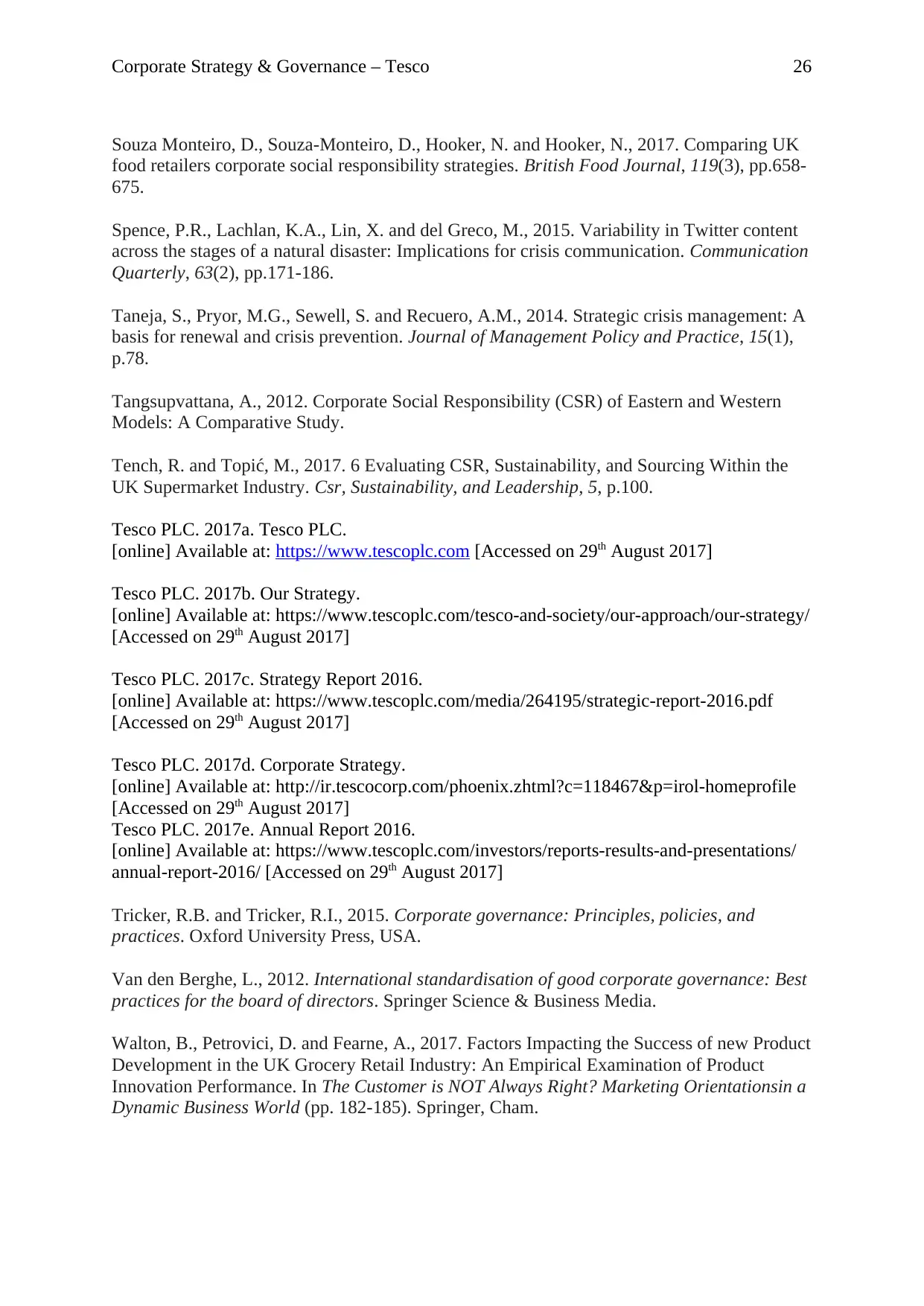
Corporate Strategy & Governance – Tesco 26
Souza Monteiro, D., Souza-Monteiro, D., Hooker, N. and Hooker, N., 2017. Comparing UK
food retailers corporate social responsibility strategies. British Food Journal, 119(3), pp.658-
675.
Spence, P.R., Lachlan, K.A., Lin, X. and del Greco, M., 2015. Variability in Twitter content
across the stages of a natural disaster: Implications for crisis communication. Communication
Quarterly, 63(2), pp.171-186.
Taneja, S., Pryor, M.G., Sewell, S. and Recuero, A.M., 2014. Strategic crisis management: A
basis for renewal and crisis prevention. Journal of Management Policy and Practice, 15(1),
p.78.
Tangsupvattana, A., 2012. Corporate Social Responsibility (CSR) of Eastern and Western
Models: A Comparative Study.
Tench, R. and Topić, M., 2017. 6 Evaluating CSR, Sustainability, and Sourcing Within the
UK Supermarket Industry. Csr, Sustainability, and Leadership, 5, p.100.
Tesco PLC. 2017a. Tesco PLC.
[online] Available at: https://www.tescoplc.com [Accessed on 29th August 2017]
Tesco PLC. 2017b. Our Strategy.
[online] Available at: https://www.tescoplc.com/tesco-and-society/our-approach/our-strategy/
[Accessed on 29th August 2017]
Tesco PLC. 2017c. Strategy Report 2016.
[online] Available at: https://www.tescoplc.com/media/264195/strategic-report-2016.pdf
[Accessed on 29th August 2017]
Tesco PLC. 2017d. Corporate Strategy.
[online] Available at: http://ir.tescocorp.com/phoenix.zhtml?c=118467&p=irol-homeprofile
[Accessed on 29th August 2017]
Tesco PLC. 2017e. Annual Report 2016.
[online] Available at: https://www.tescoplc.com/investors/reports-results-and-presentations/
annual-report-2016/ [Accessed on 29th August 2017]
Tricker, R.B. and Tricker, R.I., 2015. Corporate governance: Principles, policies, and
practices. Oxford University Press, USA.
Van den Berghe, L., 2012. International standardisation of good corporate governance: Best
practices for the board of directors. Springer Science & Business Media.
Walton, B., Petrovici, D. and Fearne, A., 2017. Factors Impacting the Success of new Product
Development in the UK Grocery Retail Industry: An Empirical Examination of Product
Innovation Performance. In The Customer is NOT Always Right? Marketing Orientationsin a
Dynamic Business World (pp. 182-185). Springer, Cham.
Souza Monteiro, D., Souza-Monteiro, D., Hooker, N. and Hooker, N., 2017. Comparing UK
food retailers corporate social responsibility strategies. British Food Journal, 119(3), pp.658-
675.
Spence, P.R., Lachlan, K.A., Lin, X. and del Greco, M., 2015. Variability in Twitter content
across the stages of a natural disaster: Implications for crisis communication. Communication
Quarterly, 63(2), pp.171-186.
Taneja, S., Pryor, M.G., Sewell, S. and Recuero, A.M., 2014. Strategic crisis management: A
basis for renewal and crisis prevention. Journal of Management Policy and Practice, 15(1),
p.78.
Tangsupvattana, A., 2012. Corporate Social Responsibility (CSR) of Eastern and Western
Models: A Comparative Study.
Tench, R. and Topić, M., 2017. 6 Evaluating CSR, Sustainability, and Sourcing Within the
UK Supermarket Industry. Csr, Sustainability, and Leadership, 5, p.100.
Tesco PLC. 2017a. Tesco PLC.
[online] Available at: https://www.tescoplc.com [Accessed on 29th August 2017]
Tesco PLC. 2017b. Our Strategy.
[online] Available at: https://www.tescoplc.com/tesco-and-society/our-approach/our-strategy/
[Accessed on 29th August 2017]
Tesco PLC. 2017c. Strategy Report 2016.
[online] Available at: https://www.tescoplc.com/media/264195/strategic-report-2016.pdf
[Accessed on 29th August 2017]
Tesco PLC. 2017d. Corporate Strategy.
[online] Available at: http://ir.tescocorp.com/phoenix.zhtml?c=118467&p=irol-homeprofile
[Accessed on 29th August 2017]
Tesco PLC. 2017e. Annual Report 2016.
[online] Available at: https://www.tescoplc.com/investors/reports-results-and-presentations/
annual-report-2016/ [Accessed on 29th August 2017]
Tricker, R.B. and Tricker, R.I., 2015. Corporate governance: Principles, policies, and
practices. Oxford University Press, USA.
Van den Berghe, L., 2012. International standardisation of good corporate governance: Best
practices for the board of directors. Springer Science & Business Media.
Walton, B., Petrovici, D. and Fearne, A., 2017. Factors Impacting the Success of new Product
Development in the UK Grocery Retail Industry: An Empirical Examination of Product
Innovation Performance. In The Customer is NOT Always Right? Marketing Orientationsin a
Dynamic Business World (pp. 182-185). Springer, Cham.
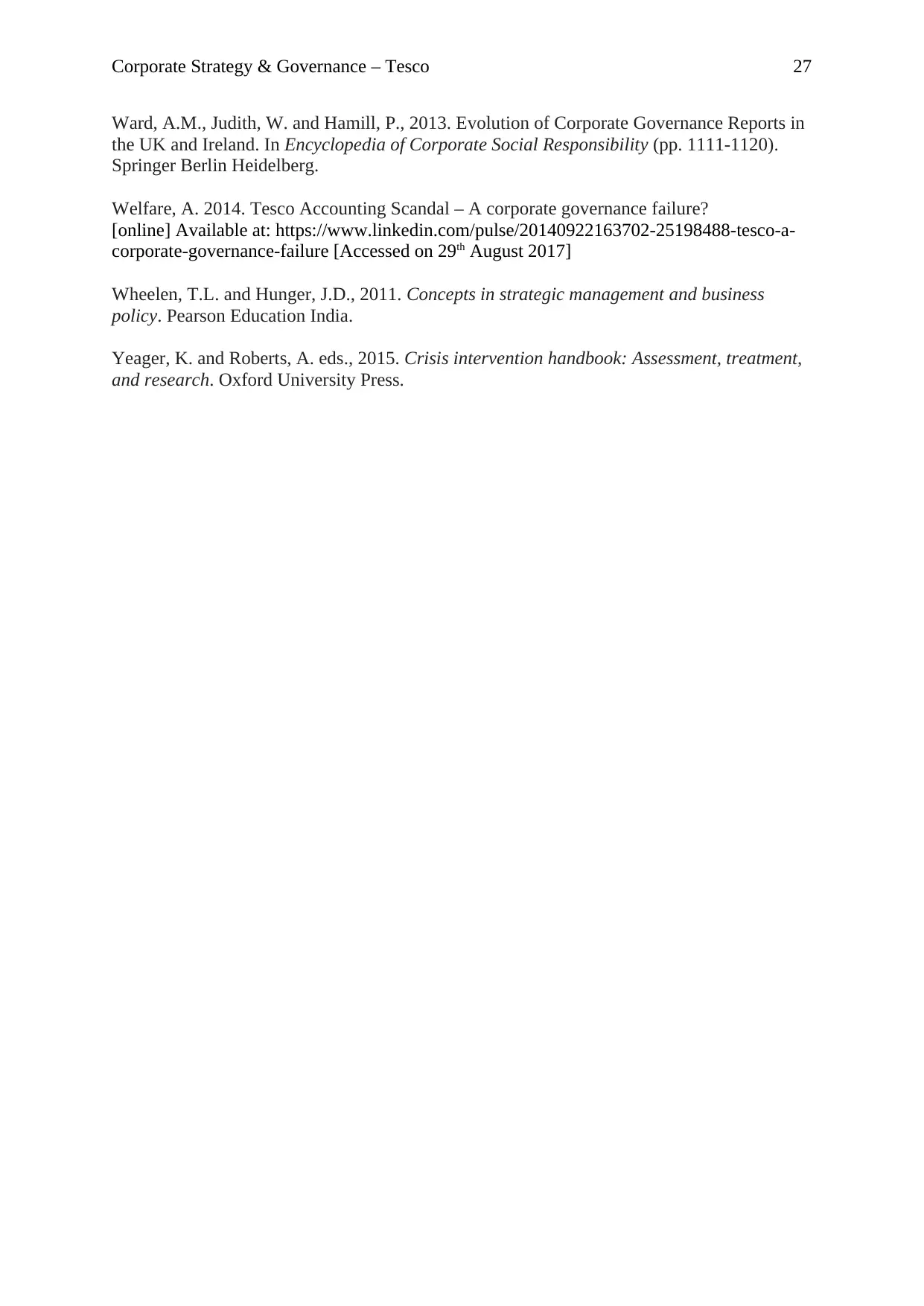
Corporate Strategy & Governance – Tesco 27
Ward, A.M., Judith, W. and Hamill, P., 2013. Evolution of Corporate Governance Reports in
the UK and Ireland. In Encyclopedia of Corporate Social Responsibility (pp. 1111-1120).
Springer Berlin Heidelberg.
Welfare, A. 2014. Tesco Accounting Scandal – A corporate governance failure?
[online] Available at: https://www.linkedin.com/pulse/20140922163702-25198488-tesco-a-
corporate-governance-failure [Accessed on 29th August 2017]
Wheelen, T.L. and Hunger, J.D., 2011. Concepts in strategic management and business
policy. Pearson Education India.
Yeager, K. and Roberts, A. eds., 2015. Crisis intervention handbook: Assessment, treatment,
and research. Oxford University Press.
Ward, A.M., Judith, W. and Hamill, P., 2013. Evolution of Corporate Governance Reports in
the UK and Ireland. In Encyclopedia of Corporate Social Responsibility (pp. 1111-1120).
Springer Berlin Heidelberg.
Welfare, A. 2014. Tesco Accounting Scandal – A corporate governance failure?
[online] Available at: https://www.linkedin.com/pulse/20140922163702-25198488-tesco-a-
corporate-governance-failure [Accessed on 29th August 2017]
Wheelen, T.L. and Hunger, J.D., 2011. Concepts in strategic management and business
policy. Pearson Education India.
Yeager, K. and Roberts, A. eds., 2015. Crisis intervention handbook: Assessment, treatment,
and research. Oxford University Press.
1 out of 27
Related Documents
Your All-in-One AI-Powered Toolkit for Academic Success.
+13062052269
info@desklib.com
Available 24*7 on WhatsApp / Email
![[object Object]](/_next/static/media/star-bottom.7253800d.svg)
Unlock your academic potential
© 2024 | Zucol Services PVT LTD | All rights reserved.



